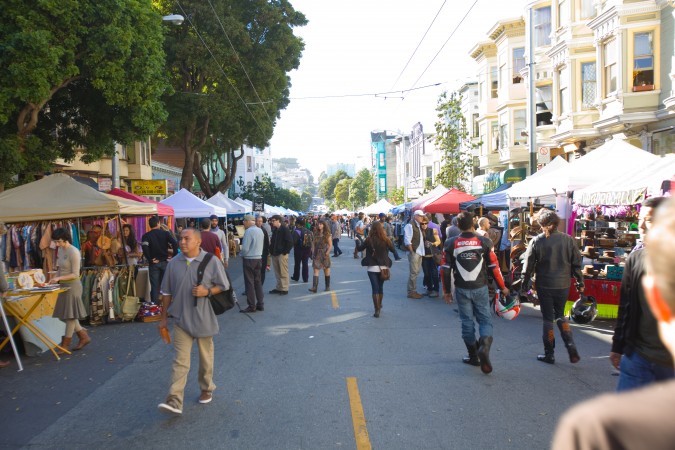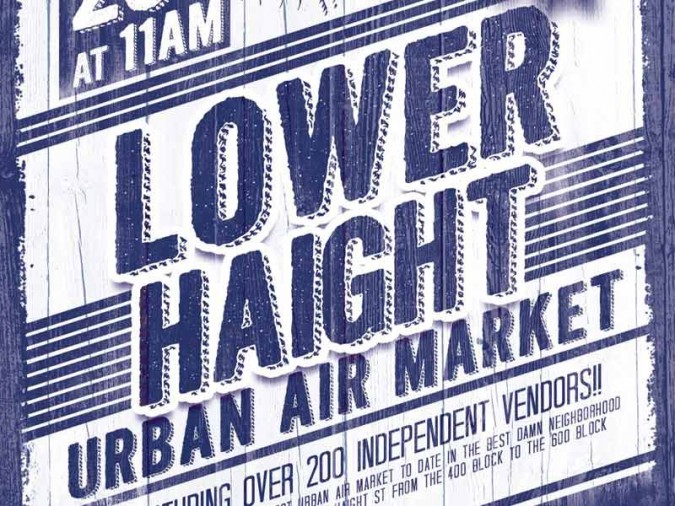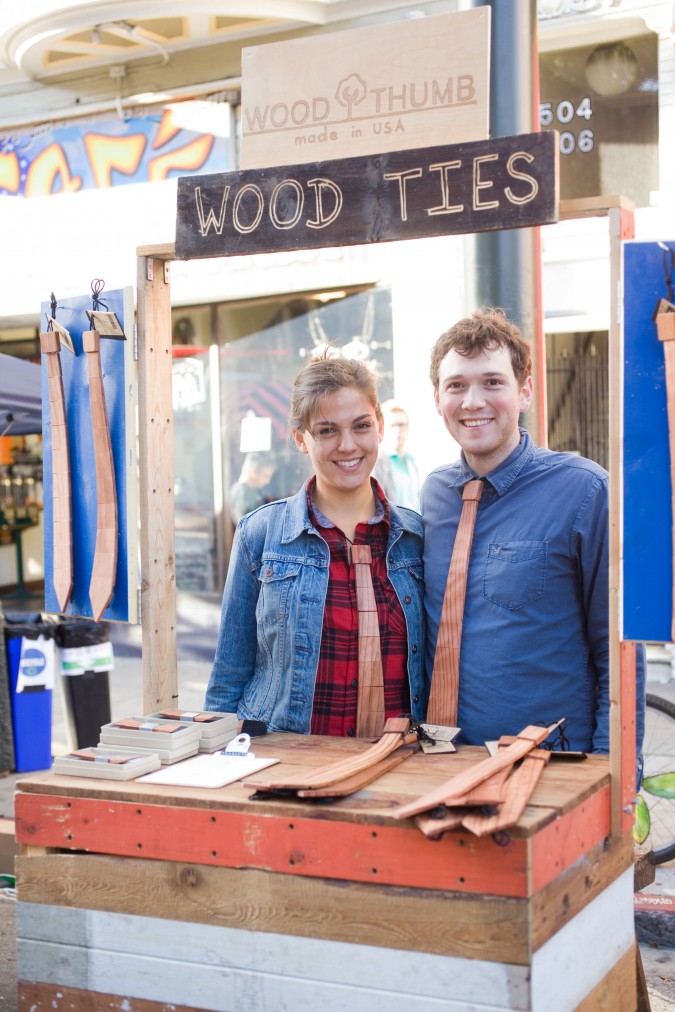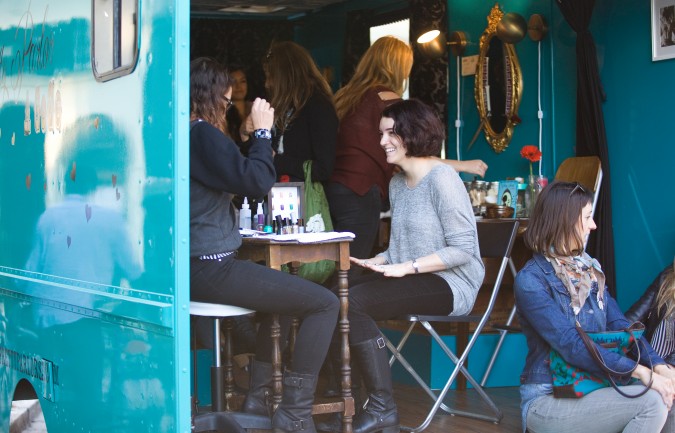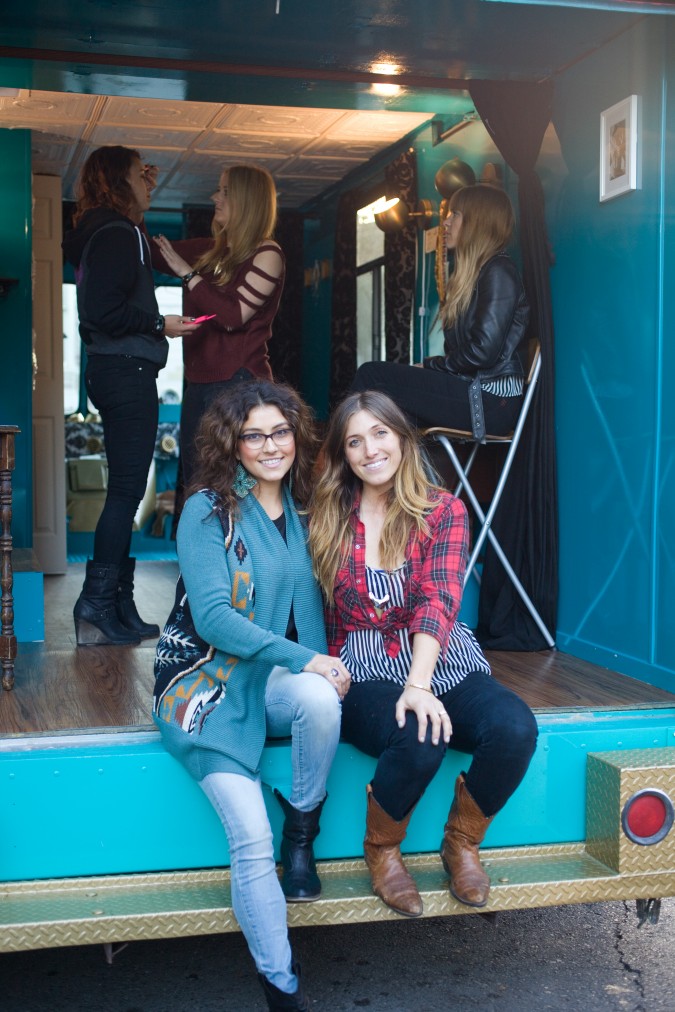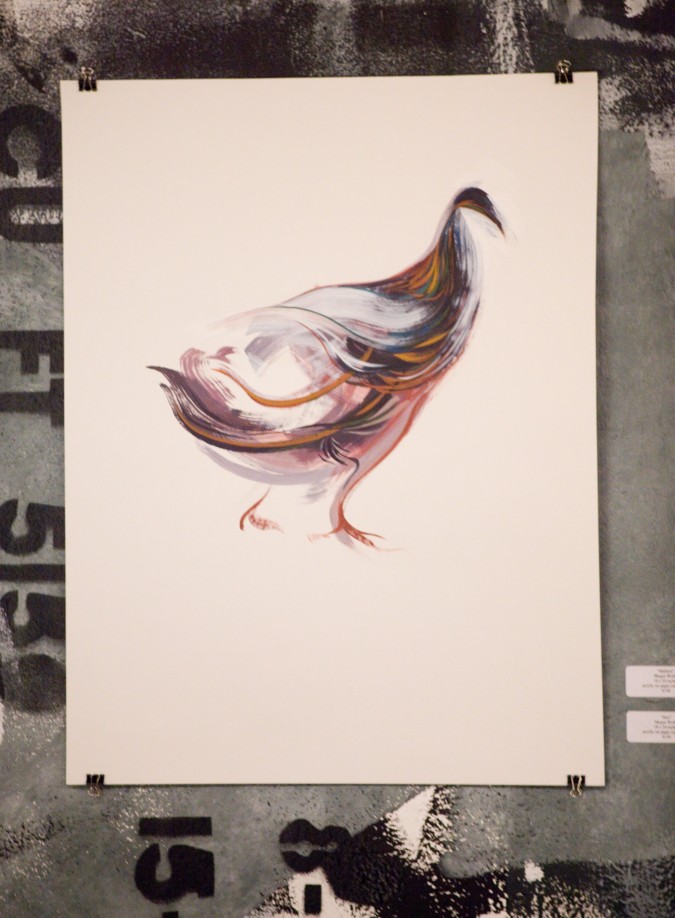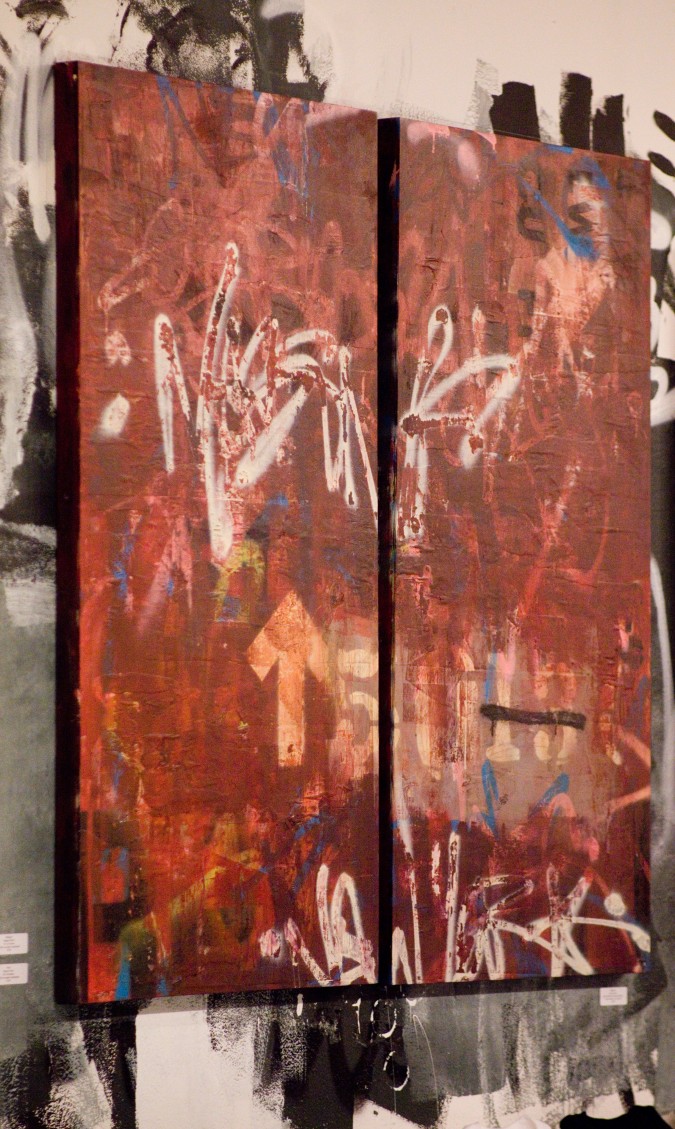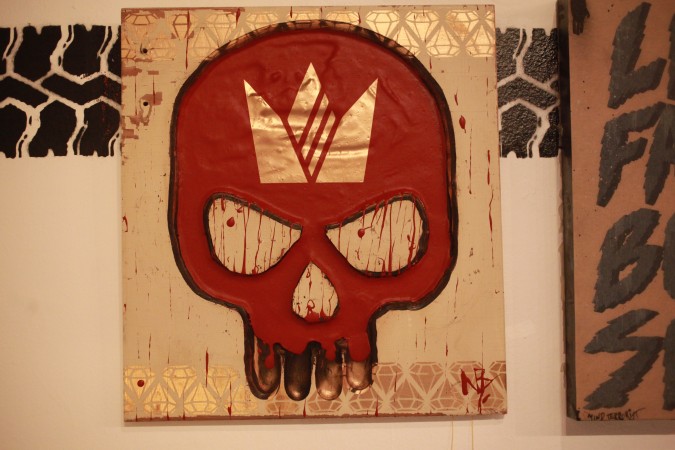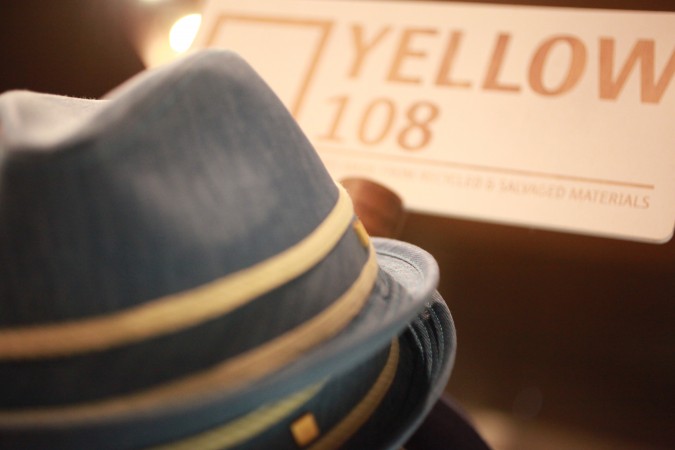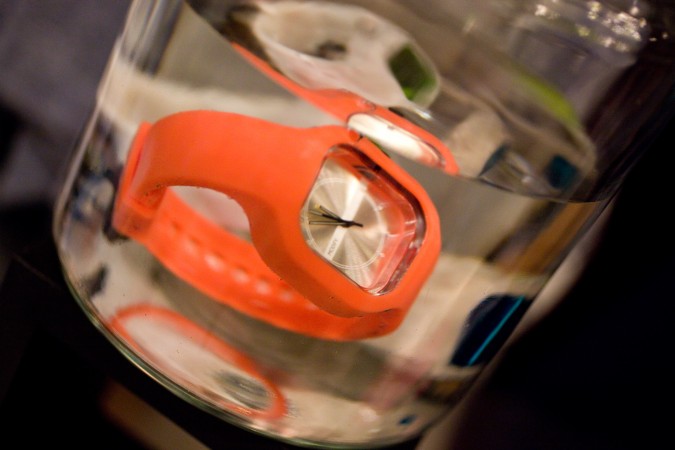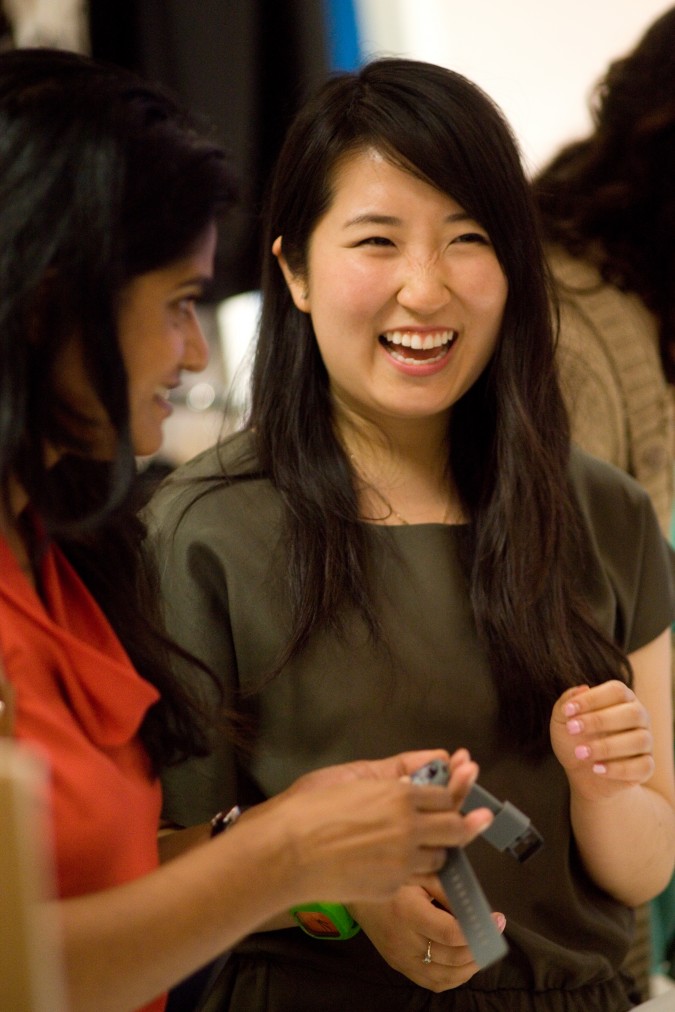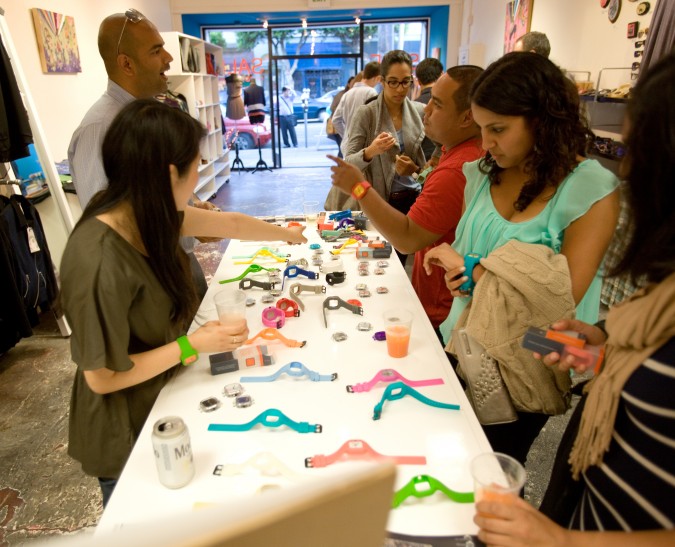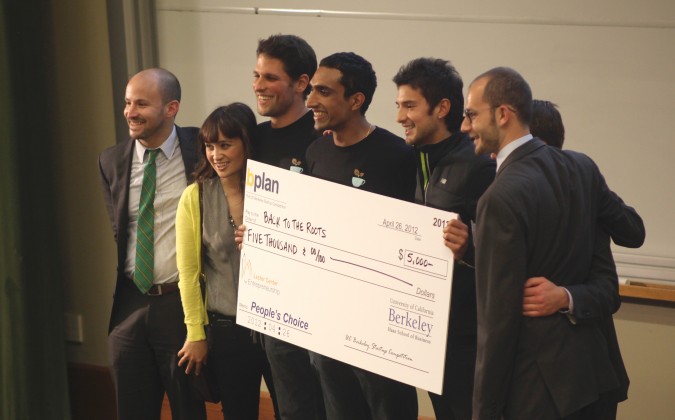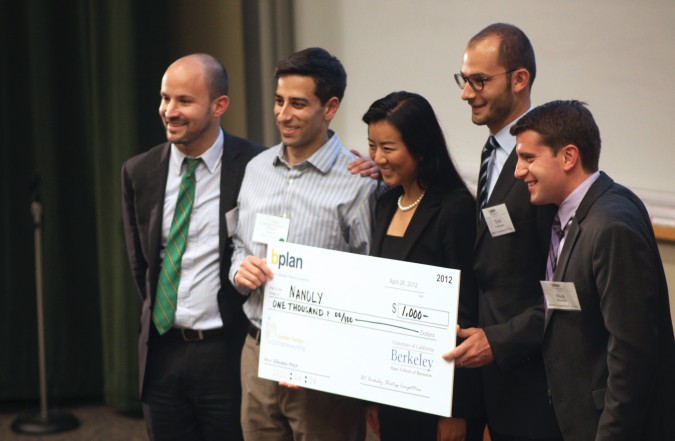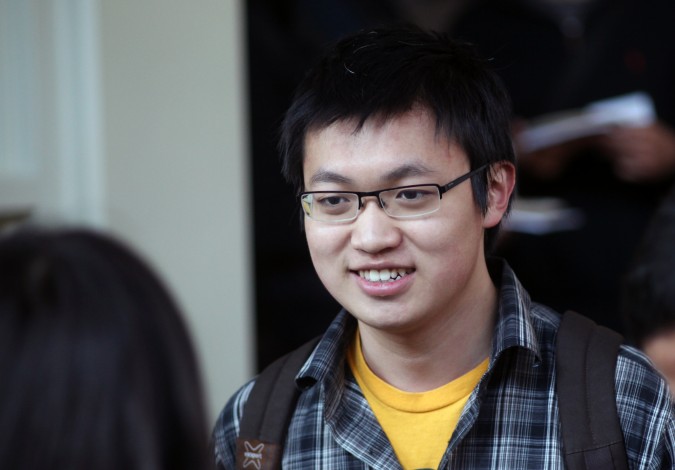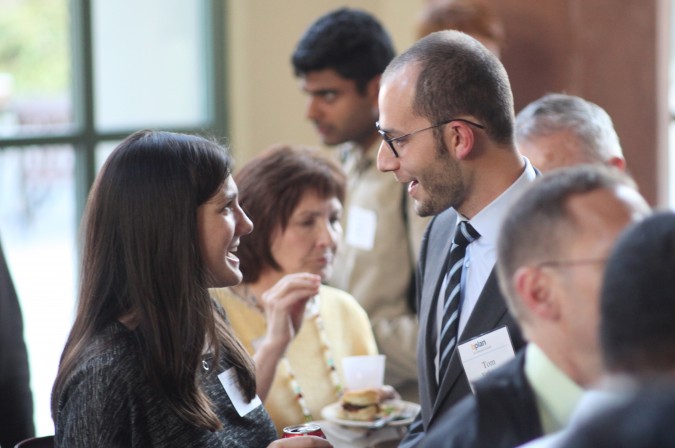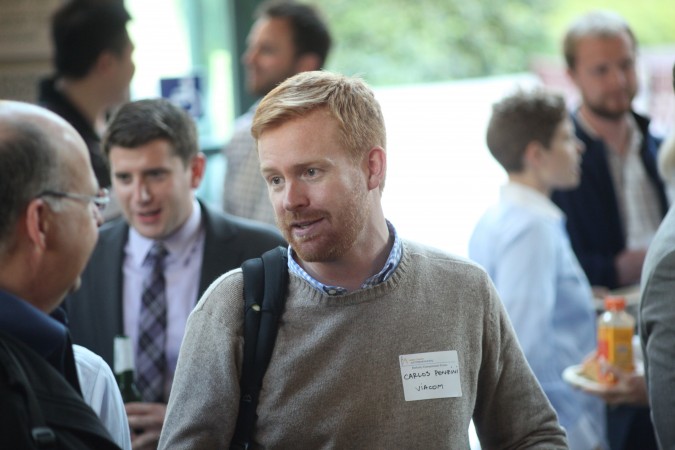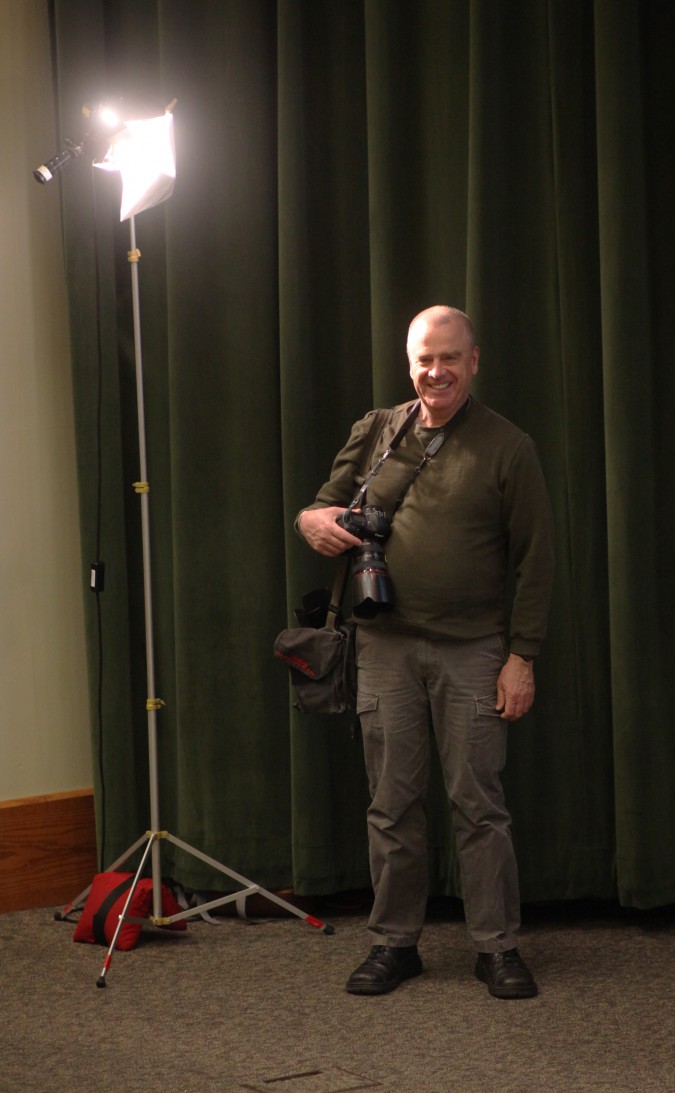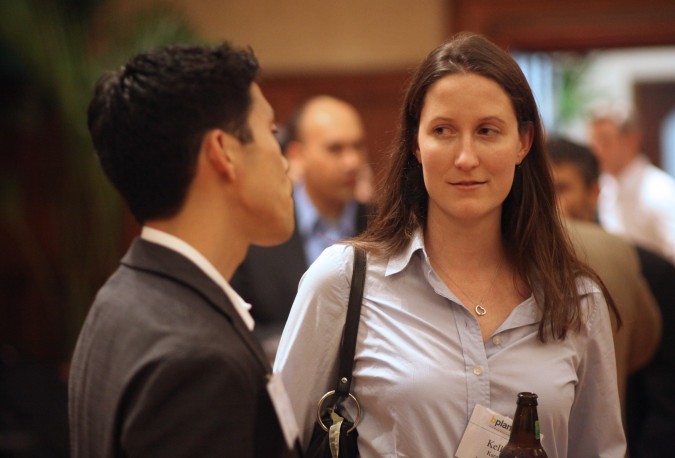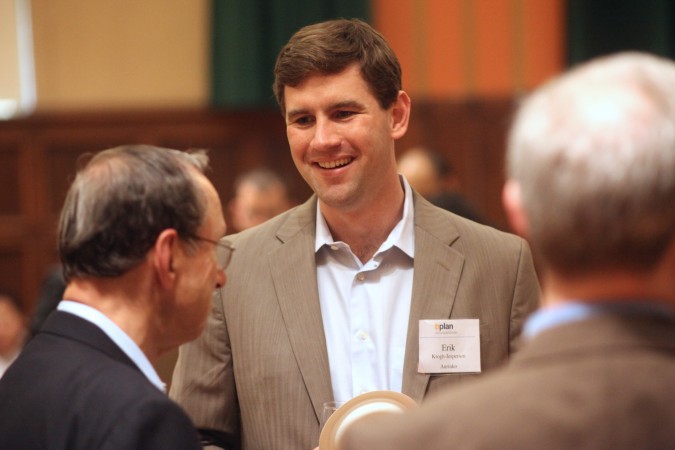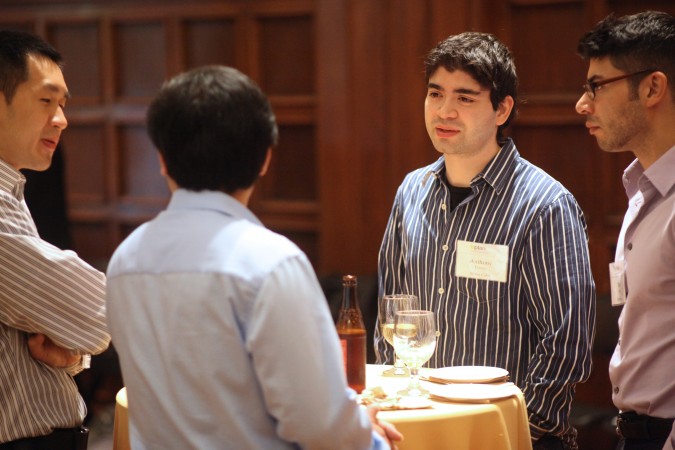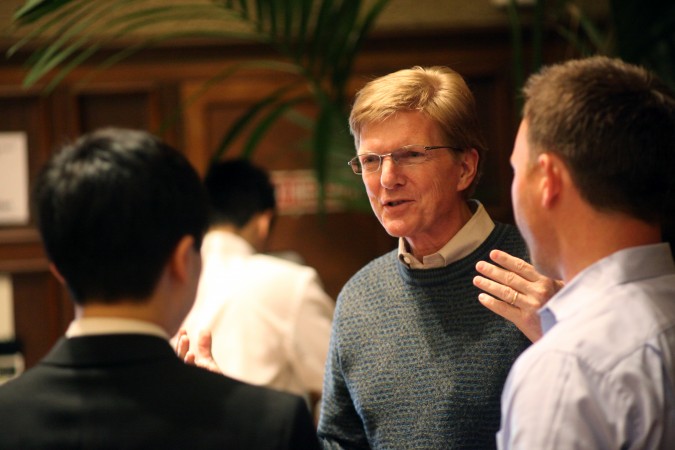Archive for the ‘Modify Watches’ tag
Interviews with 10 entrepreneurs at the Lower Haight Urban Air Market, October 20, 2012, San Francisco, California USA
On Saturday, October 20, 2012, I attended the Lower Haight Urban Air Market. The two most commercially significant blocks, from 400 to 600, of the hip lower Haight street neighborhood of San Francisco, California USA were cleared of cars and closed for this interesting small street fair.
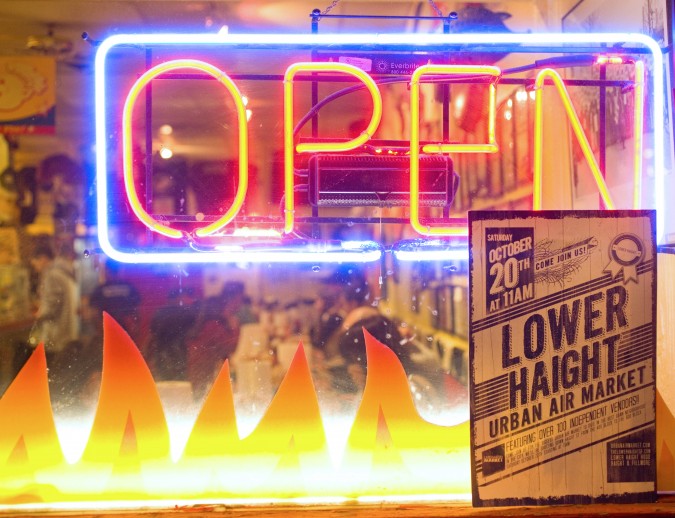
Memphis Minnies Barbeque Joint and Smokehouse, 576 Haight Street, San Francisco, California, October 20, 2012
Here’s a photograph of the poster advertising the Lower Haight Urban Air Market. The window is that of Memphis Minnies Barbeque Joint and Smokehose at 576 Haight Street. I took this picture after the sun went down but before it was completely dark. I haven’t eaten at Memphis Minnies, but I suspect it has quite a following given I see it has 1,127 reviews on Yelp today.
This project must have taken some real effort to plan and execute, because San Francisco’s Municipal Railway, MUNI, runs electric trolley buses on all of Haight Street. This street fair required that non-tethered buses be used instead for the day.
I don’t hang out in the lower Haight much, but Devon Chulick, one of the co-owners of the clothing store and art gallery D-Structure, alerted me to this fair via his store’s Facebook page. Since I’ve met some interesting people though Chulick in the past, I thought it would be smart to attend as a blogger to interview the most interesting entrepreneurs I could find, including the following ten entrepreneurs:
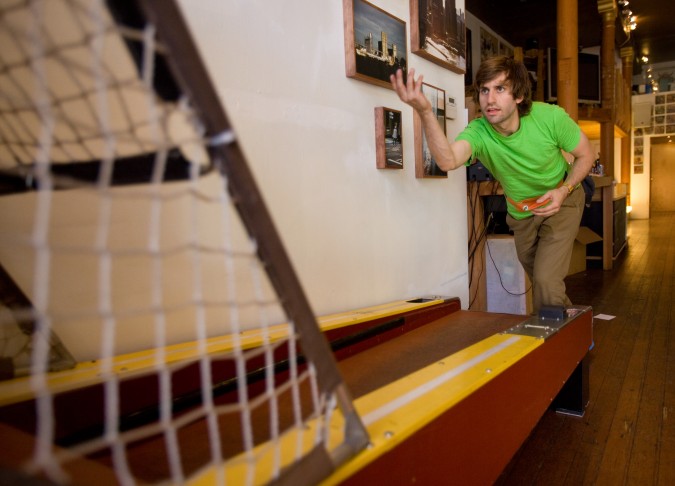
Joey Mucha playing his Skee Ball machine at D-Structure boutique on Haight Street in San Francisco California, October 20, 2012
The first entrepreneur I met was Joey Mucha. He buys used Skee Ball arcade machines, fixes them up, and places them at interesting non-arcade locations. He has a shipping container full of Skee Ball machines, and he knows how to fix them, even to the point of being able to diagnose and replace a bad computer chip on the machine’s scoring computer.
Mucha has one of his machines in Chulick’s D-Structure, and Mucha opened the machine up while I was there, so I could see how the score calculation system works. You can see Mucha playing the D-Structure Skee Ball machine in the photo above.
Amazingly, you can now play Skee Ball on your smart phone.
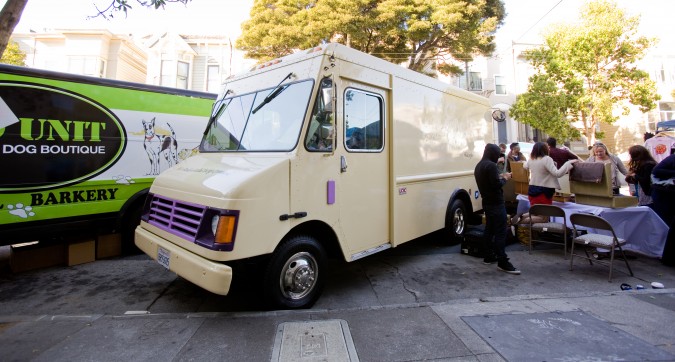
Jasy B clothing boutique inside a converted truck October 20, 2012, Haight Street, San Francisco, California USA
The second entrepreneur I met was Jasmin Baros. Baros introduced me to the concept of a clothing boutique being located in a converted delivery truck. I had never seen such a boutique, or even heard of them, until Saturday.
Baros is an accountant by profession. Her first experiment ten years ago with switching to retail didn’t pan out a after six month run.
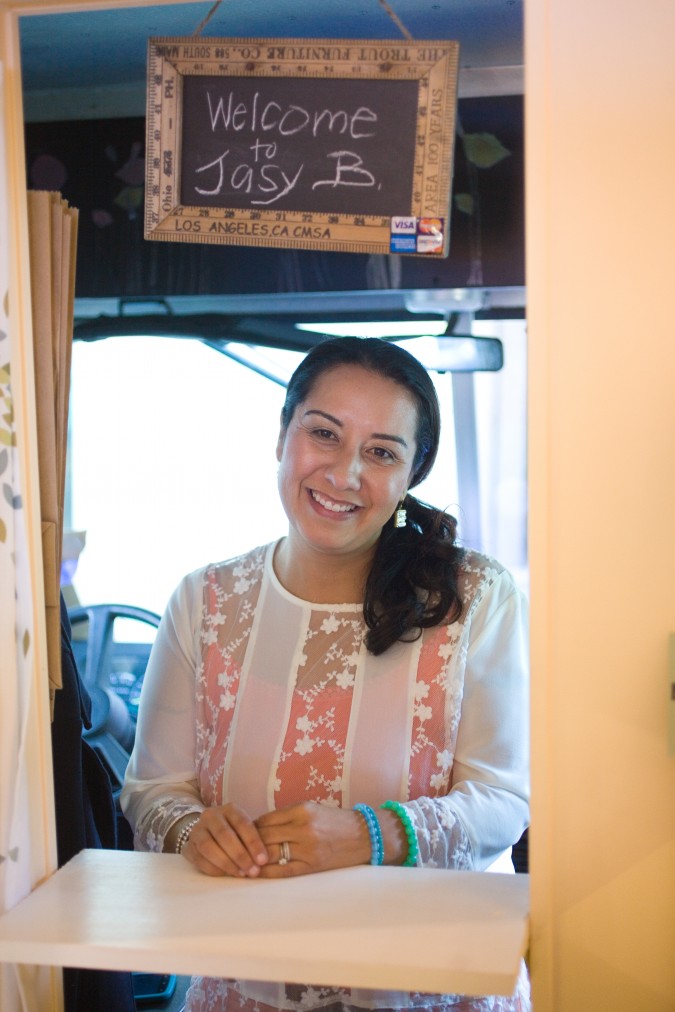
Jasmin Baros owner of http://jasybtruck.com photographed by Kevin Warnock, October 20, 2012, Haight Street Urban Air Market, San Francisco California USA
Her refurbished truck, just six weeks new, is her second attempt at retail, and I think her chances are better than 50/50 for a success. She bought the truck already freshly painted from a photographer for just USD $6,000, and only had to spend $2,000 having her logo painted on the side. It would have likely cost her $6,000 just for the fresh paint if she didn’t find an already freshly painted used truck.
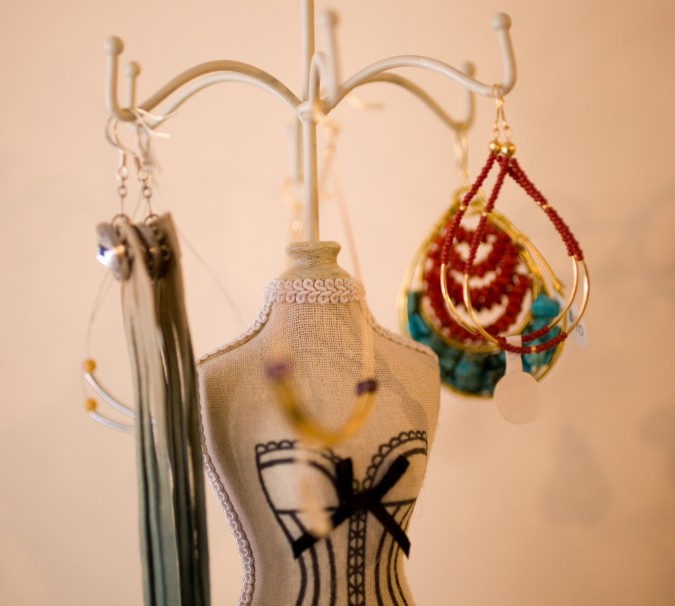
Jewelry for sale on Jasy B clothing boutique truck at Lower Haight Urban Air Market, October 20, 2012, San Francisco, California USA
Baros’ total cost to get into business she told me came to $25,000 — likely a fraction what it would cost to open a traditional retail boutique in leased store front space.
The truck — officially named the Jasy B Truck — is cute and inviting. The ceiling is pressed tin like you’d see in a vintage building. There is wainscoting on the walls. There is directional spot lighting. The colors are right. There’s a dedicated staircase with rails at the rear, where the door rolls up like a garage door. When the truck is parked at a 45% angle relative to the sidewalk, customers can just climb on board, in a way that feels natural and welcoming.
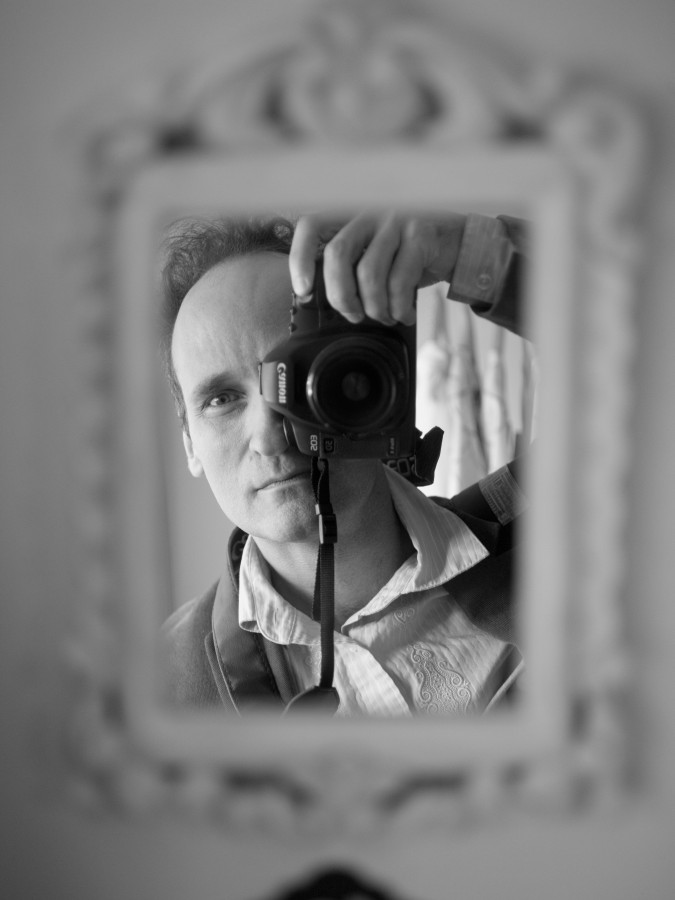
Kevin Warnock self portrait inside Jasy B truck clothing boutique, October 20, 2012, Lower Haight Urban Air Market, San Francisco, California USA
The Jasy B boutique on wheels had a wall mirror next to its jewelry display. I caught a glimpse of myself in this mirror, and since the mirror was small, it neatly framed my head. I snapped a picture with my Canon 5D Mark II digital camera I used to take all the photographs that illustrate this post. Note that I uploaded the pictures at full camera resolution. Click on them twice in delayed succession to see the full size versions, which are 21 megapixels.
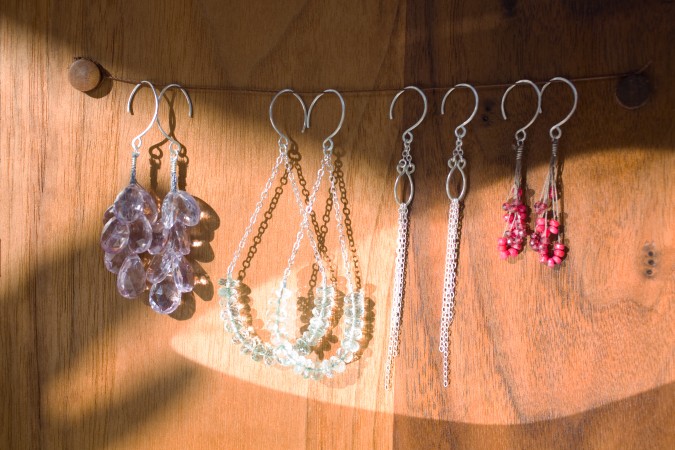
Sandra Kathleen Jewelry for sale at Lower Haight Urban Air Market, October 20, 2012, San Francisco, California USA
The third entrepreneur I met was Sandra Bowling, owner of Sandra Kathleen Jewelry. Bowling makes the jewelry. I asked permission to take the above photograph. Bowling gave permission and thanked me for asking permission. She said one woman particularly irritated her by taking pictures without asking, and when confronted, the photographer said she was going to send the pictures to a friend or relative (I can’t recall which) that also made jewelry for profit — to copy and then sell! I presume these designs are not patented, but still, I can see it being annoying having people taking pictures with the express intent of taking your work to profit from it.
Bowling had her jewelry nicely displayed, and I loved the light as shown in my picture above. The brighter spot of light in the lower right was from light bouncing off the hand mirror she had on the table.
Sadly, I forgot to photograph Sandra Bowling.
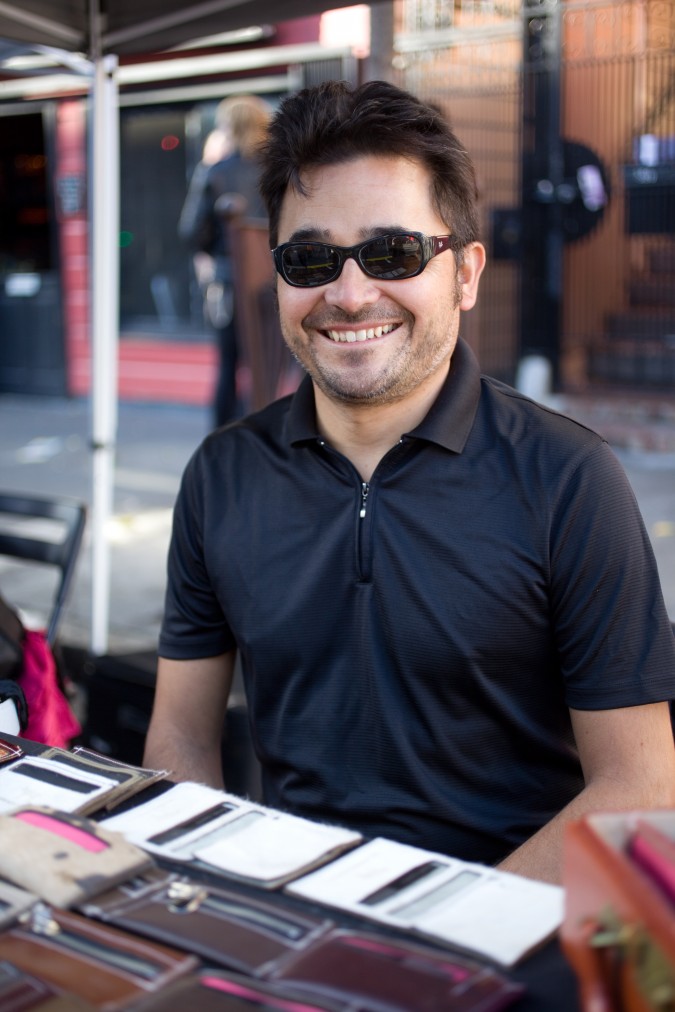
Angel Cantu founder of Halo Bender Design, a maker of upcycled leather wallets made from furniture leather samples, October 20, 2012, Lower Haight Urban Air Market, San Francisco, California USA
The fourth entrepreneur I met was Angel Cantu, above, founder of Halo Bender Design.
Halo Bender Design makes wallets for men from the leather swatches furniture stores have on hand to help buyers decide what leather to buy for custom ordered chairs and sofas. Cantu discovered that stores replace their swatch books from time to time, and when they do, they discard the old books. Cantu has learned that he can rescue the leather from landfill by giving the proprietor a few wallets he made from earlier swatch books. Since his materials cost is so low — thread and his time, this is a great exchange. The swatches he showed me looked brand new, and the wallets looked fresh and brand new as well, with no hint that their leather was perhaps already years old.

Wallets made by Halo Bender Design from furniture leather samples October 20, 2012, at Lower Haight Urban Air Market, San Francisco, California USA
Cantu cut the first wallets by hand with scissors. Then, he joined TechShop, a well equipped workshop that rents access to tools like a health club rents access to exercise machines. TechShop has a laser cutter to replace scissors, and industrial sewing machines capable of stitching leather. TechShop has spawned many small businesses, including DoDo Case, which makes an Apple iPad case that looks like a leather hard cover book. Current United States President Barack Obama carries his iPad in a DoDo Case brand case.
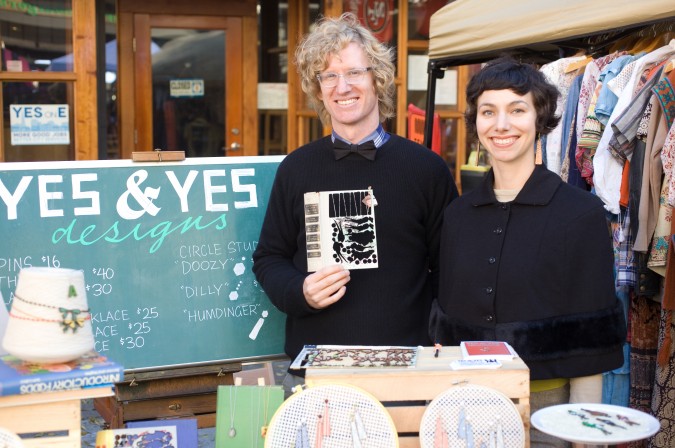
Laura Bruland the founder of Yes and Yes Designs with her boyfriend Julien Shields that works with her in the business, October 20, 2012, San Francisco, California USA
The fifth entrepreneur I met was Laura Bruland, founder of Yes & Yes Designs.
Yes & Yes is another TechShop success story, and she’s featured on their website.
Yes & Yes makes jewelry from old hard cover book covers. Bruland uses TechShop’s laser cutter to slice through the canvas and cardboard book covers in a way that would be nearly impossible with a jig saw or a Xacto knife.
In the picture above of Bruland with her boyfriend Julien Shields you can see Shields holding a book cover that has had over two dozen pieces of jewelry cut from it. The row of trapezoids on top became earrings, in the style you see Bruland wearing in the same picture.

Pins made from the covers of old books by Yes and Yes Designs, over rice, October 20, 2012, San Francisco, California USA
Many of Bruland’s designs feature the silhouettes of stylish women — Bruland confided that the designs themselves are vintage, derived from old dress making patterns. The pins above are examples of these designs. Look at how typography plays a part of her designs.
Like the upcycled wallets made by Angel Cantu, Bruland’s cost of materials is extremely low. She laser cuts out of date and falling apart books of nominal value as books. I suspect she pays little or nothing for most of the books.
I saw customers buying Bruland’s products, and saying nice things about them while doing so, something I didn’t happen to catch with any of the other artists at Saturday’s fair.
The sixth entrepreneur I met was Chris Steinrueck, co-founder of Wood Thumb, a maker of men’s ties and bow ties, among other products.
Wood Thumb recycles redwood it receives for free from Recology, the company that picks up the trash from homes and businesses in San Francisco. Recology sifts through the trash it picks up and hands the redwood planks it finds to Wood Thumb, which then planes and mills the ties into shape. The ties are cut on a ShopBot CNC router.
I love the upcycling and recycling demonstrated at this fair.
Wood Thumb started out at and still does some work at TechShop, like Yes & Yes Designs and Halo Bender Design, also profiled in this post.
The ties are made from redwood because redwood is attractive and particularly because it is light in weight. Chris, who runs the company with his co-founder brother David Steinrueck, said people can feel the difference in weight between redwood and other attractive wood, and prefer the light weight redwood. Conveniently, Wood Thumb ties are rot resistant, in case you forget your tie in the woods, unlike silk or wool ties.
Wood Thumb appears to be doing well, selling thousands of ties per month as of the end of 2011.
I photographed Chris with his girlfriend Rebecca Carrillo at their booth, also made from reclaimed wood.
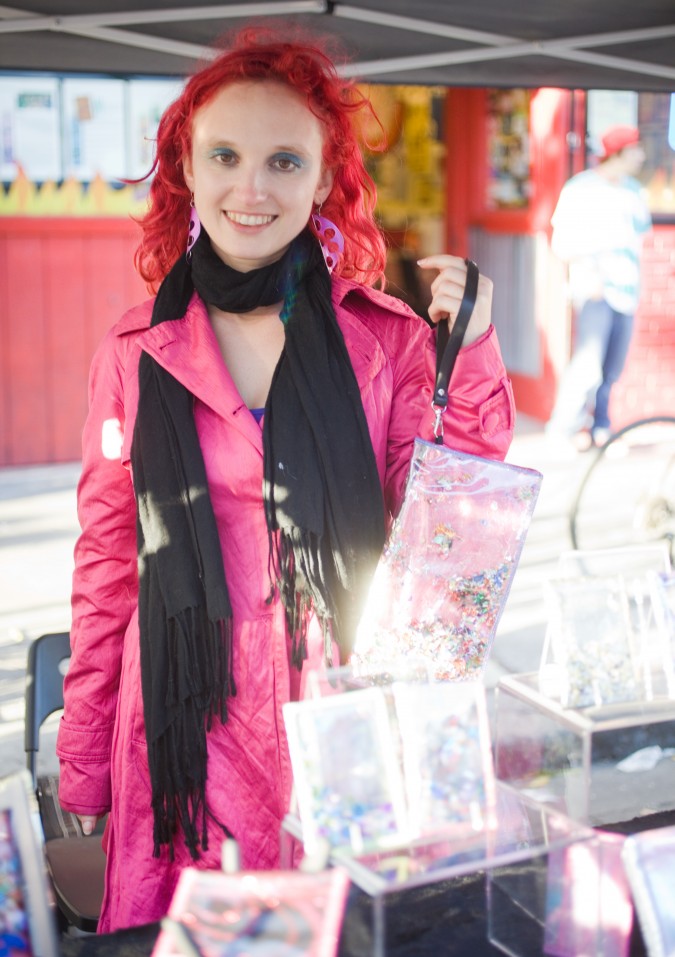
Sarah Boll owner of Glitter Disaster at Lower Haight Urban Air Market, October 20, 2012. Photograph by Kevin Warnock.
The seventh entrepreneur I met was Sarah Boll, who was the most interestingly dressed, with exceptionally red hair, vivid glittery blue eye shadow, a magenta jacket and wild black and white stretch pants she personally sewed. It was a look that is completely consistent with her product — glittery purses, clutches and related accessories. This was Boll’s first time selling at a street fair.
Her company name is Glitter Disaster — a name I really like.
The glitter you see in the clear vinyl is sandwiched between two layers, where it’s free to slide around like snow in a snow globe. The glitter never touches what you put into her clutches and purses. The random and ever changing glitter display catches your eye, and I think these products were the most inspired and unusual of everything I saw on Saturday.
Boll has an online store on Etsy, as well as a Facebook page and a Tumblr account.
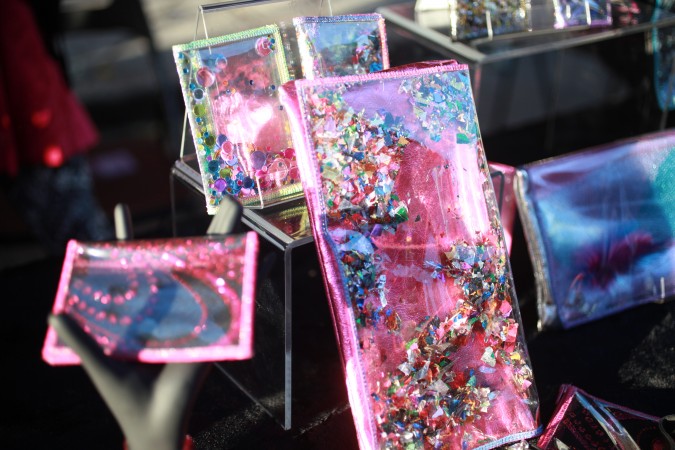
Glamorous accessories for sparkle connoisseurs by Glitter Disaster, October 20, 2012, Lower Haight Urban Air Market, San Francisco, California USA
The vinyl sheets are sewn not with a sewing machine but with a serger, called overlock machines outside of North America for the overlock stitches they create. If you look inside some of your clothes, you will see overlock seams. A serger is a fascinating machine. The overlock seam is not one thread but multiple threads, from separate spools. This means each thread can be a different color, a feature you can see Boll used to create interest with her pieces, since she uses the overlock seams as a visible design element.
I learned about the serger several weeks ago when I was looking into what I would need to sew my own clothes. I took sewing class at Lab School, and I made quilts when I was 12 years old. I want to make some really crazy outfits I can’t find in stores. That’s when I learned I would need a sewing machine and a serger machine. I have since decided to just wait until my next trip to Shanghai and have my clothes made in the world famous Bund fabric market, which will be more productive and more fascinating, because that stupendous fabric market has so many more fabrics than you can buy in the San Francisco Bay Area.
The eighth and ninth entrepreneurs I met were Misty Briglia and Sarah LaShelle, co-founders of Pretty Parlor beauty boutique on wheels. The Pretty Parlor is also built inside a retired delivery truck, like the Jasy B Truck. The beauty business is tightly regulated, unlike the retail clothing business. Thus, the Pretty Parlor truck has a bathroom complete with running water in a charming old world porcelain sink. There’s is room for a wheelchair to move around on board. A wheelchair ramp to board is in the works. I wonder if they can find a suitable aluminum ramp at a salvage yard that dismantles U-Haul trucks — those ramps are really well made.
In the photograph above, the woman in the gray sweater seated had just have her fingernails painted with intricate designs — a different design on each finger. I introduced myself to her and she let me see the results, which she really liked. She gave me permission to include her on this blog. The manicurist Mia Rubie, on the left, had her manicurist license out for display, just like you would see in a fixed location shop. I loved the antique furniture throughout the truck.
In the photograph above the founders Briglia and LaShelleare are sitting on the rear step of the truck. In the background, from let to right, are:
- Marie Rubie — Nail Artist
- Marla Kay — Esthetician
- Katie Stosic — Stylist and Receptionist
All of the trucks had generators chained outside sitting on the pavement. But I saw no heavy electrical requirement in any of the trucks. Since the trucks are only parked for the day, I think they all could switch to LED lighting and power themselves from a dedicated ‘house’ battery bank like those in recreational vehicles and bus conversions that charges from the vehicle alternator while driving. The generators are noisy and unnecessary. From what I could tell, none of the trucks contemplate air conditioning the sales floor while parked, but that’s the only reason for a large generator like the ones I saw.

Products for sale at Pretty Parlor beauty boutique on wheels, October 20, 2012, San Francisco, California USA
I recommend adding a solar panel to the roof to keep the batteries charged while the vehicles are in storage, and also to be able to boast that the stores are in part ‘powered by the sun.’ Solar panels are very affordable these days.
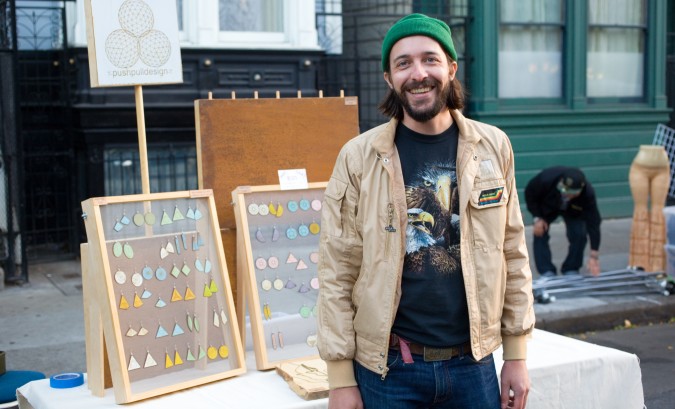
Aaron Bray, owner of PushPullArtDesign.com, October 20, 2012, Lower Haight Urban Air Market, San Francisco, California USA
The tenth and last entrepreneur I met was Aaron Bray, owner of Push Pull Art Design. Bray was at the fair selling his brand new but vintage appearing earrings and pendants.
He cuts the designs from steel with tin snips, and then flattens the cut edges with weights. He then treats the metal to give it a rich aged patina, rust I believe, that makes it resemble copper. I don’t know how Bray paints the pieces, and I could find no description on his website about how they are made. In fact, I could find almost no information about Bray online, and in particular, I could not find any pictures of him. I had Bray’s full cooperation to take the picture you see of him here.
I love Bray’s work, but I don’t understand why he is keeping such a low, low profile online. He should examine how Sarah Boll is using the Internet to promote her art. Bray’s online store is one example of how his low profile is hurting his finances. He sells only his discontinued work on his online store, but there are no ‘buy now’ or ‘add to cart’ buttons to be found. The price is a hyperlink, and if you click that you are taken to PayPal where you can buy that item. But that’s is expecting far too much from people to start clicking links looking for a way to buy. There needs to be a buy button on every item for sale, without exception.

Pendants by http://pushpullartdesign.com, October 20, 2012, Lower Haight Urban Air Market, San Francisco, California USA
The site is so sparse that it’s off putting. I can’t read Bray’s biography or see what he looks like. I can’t learn his phone number. I can’t determine what city, state or country he lives in, except by inferring based on the shows he notes he will attend. Even then, the list is heavy on abbreviations like SF for San Francisco, California. Buyers from other parts of the world may not know what SF means. I can’t learn what stores carry his products. I can’t see his products worn by people. I can’t even learn what the products are made from or how big they are, as there is no reliable size reference in any of the pictures.
Bray has the most subtle, artistic and lovely product of any that I have reviewed here, and I offer the above criticism in the hope that he will make simple changes that I predict will measurably increase his revenues and profits. Here’s one final piece of advice: Add your products to your Etsy store, which currently has zero products for sale. From what I have heard, Etsy really works.
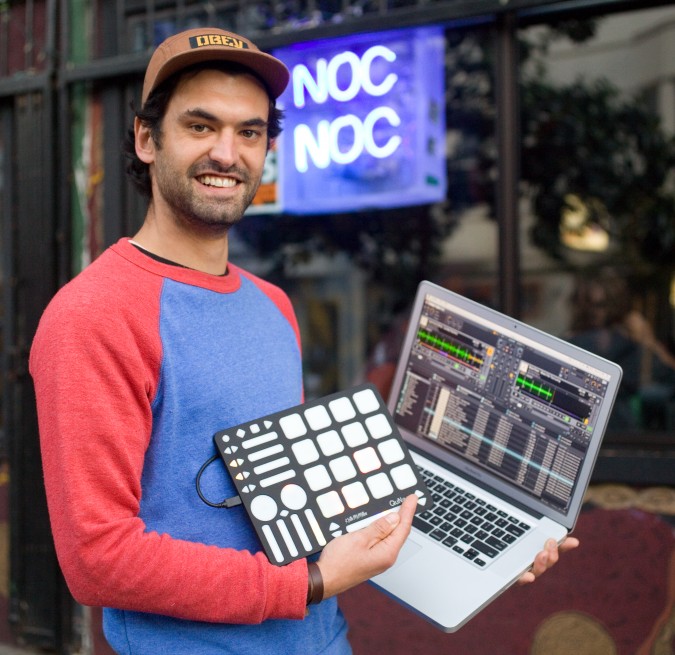
Matt Hettich is the Product Specialist / Artist Relations person at Keith McMillen Instruments, October 20, 2012. Photographed outside Noc Noc bar at 557 Haight Street, San Francisco, California USA.
The last person I met was Matt Hettich. He’s not technically an entrepreneur because he is not a founder of the company whose product he was pitching. But his product is interesting, and his approach to promoting it is also interesting, so I have included him in this post.
Hettich’s title is Product Specialist/Artist Relations. The company he works for is Keith McMillen Instruments. This company didn’t have a booth at the fair. I met Hettich as the fair was winding down, when I walked into the legendary bar Noc Noc that’s been in the same spot on lower Haight Street for decades. The decor hasn’t changed in decades — still the crazy handmade furniture and bar, which is holding up quite well considering the flow of hard living hipsters over the decades.

QuNeo 3D Pad Controller by Keith McMillen Instruments at Noc Noc bar on Haight Street, San Francisco, October 20, 2012
I met Hettich almost immediately because he was showing off the eye catching and colorful QuNeo 3D Pad Controller seen in the pictures above and below. This is MIDI controller for digital musicians and disc jockeys. The buttons on this controller are not labeled because they are mappable by software to whatever you want them to control. The buttons sense where you touch them and how hard you press, which for sounds like drum machines can be very valuable and can help musicians be more expressive.
I am not a musician, but Hettich did a great job explaining the device and why I would want one if I were a musician.

QuNeo 3D Pad Controller by Keith McMillen Instruments in use, October 20 2012, Noc Noc bar, San Francisco, California USA
Company founder Keith McMillen is a legend in the instrument business. One of the company’s customers was sitting with Hettich, and the customer compared McMillen to Robert Moog and Tom Oberheim, and said McMillen is in the same league. This stature probably explains why when his company ran a Kickstarter campaign to raise USD $15,000 he raised over ten times that amount.
The QuNeo costs just USD $249 — less than I guessed.
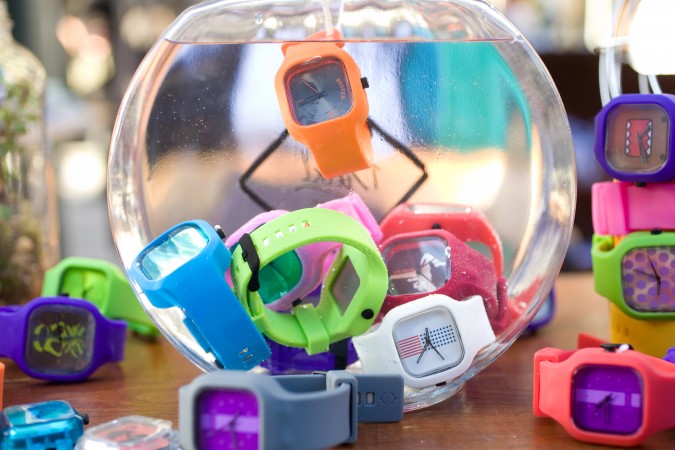
Modify Watches brand watches for sale at D-Structure at Lower Haight Urban Air Market, October 20, 2012, San Francisco, California USA
Here’s a pretty picture of some colorful silicone rubber wrist watches from Modify Watches, a brand of Modify Industries, Inc. I took this picture outside of D-Structure, where Chulick had a table of wares for sale. D-Structure carries Modify Watches at their store and online.
My friend Aaron Schwartz founded and runs Modify, and I’ve written about his products on this blog before. Schwartz has allowed me to borrow some of his products to photograph being worn by some of the models I photograph.
Schwartz’s company is a on a roll — his products were featured on the very popular United States television show The Today Show on October 3, 2012.
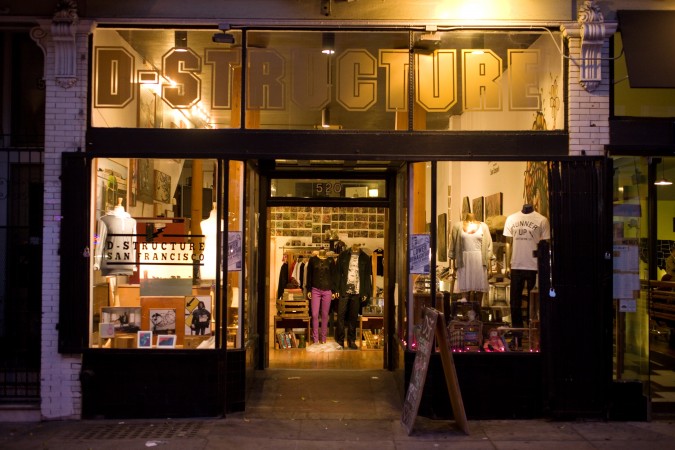
Magic Hour photograph of D Structure clothing boutique and art gallery, 520 Haight Street, San Francisco, California, October 20, 2012
After the fair ended, I took this picture of Devon Chulick’s D-Structure art gallery and boutique, just as the sun was going down. I thought the ‘magic hour’ light was flattering.

Class C motorhome belt buckle for sale by Staghound Belts at Lower Haight Urban Air Market, October 20, 2012
Finally, Staghound Belts had a booth where they sold new belts for men. They also had a collection of vintage belt buckles, including this buckle showing a Class C motorhome on a Ford van chassis. This made me think of George Lehrer, a blogger I’ve read for years. Lehrer for a decade now has lived full time in his Class-C motorhome he has named Ms. Tioga, after the brand name given by its manufacturer. He writes several times a day, and makes about USD $1,000 a month in revenue from Google Ad Words, which supplements his US Social Security retirement checks. I suspect Lehrer would like to have this buckle, and I further suspect that Staghound Belts will have it for sale for some time, as I doubt there is much demand for such a unique item.
It’s likely that Staghound made the belts they were selling, and I should have asked more questions so that I could have written about the founder as an entrepreneur. Next time I will.
[November 27, 2012 — I updated this post to name Julien Shields. The original version of this post referred to him as Laura Bruland’s boyfriend.]
Art opening at D-Structure in San Francisco featuring art by Steve Javiel, Daniel Valadez and Megan Wolfe
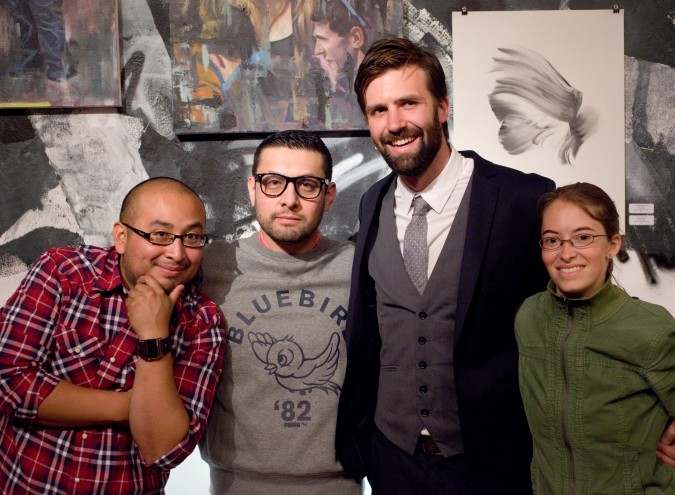
Steve Javiel, Daniel Valadez, Devon Chulick and Megan Wolfe at D-Structure, September 7, 2012. Photo by Kevin Warnock.
Yesterday evening, Friday, September 7, 2012, I attended an art opening at the hip clothing boutique and art gallery known as D-Structure.
I last wrote about D-Structure when the store hosted a trunk sale for Modify Watches.
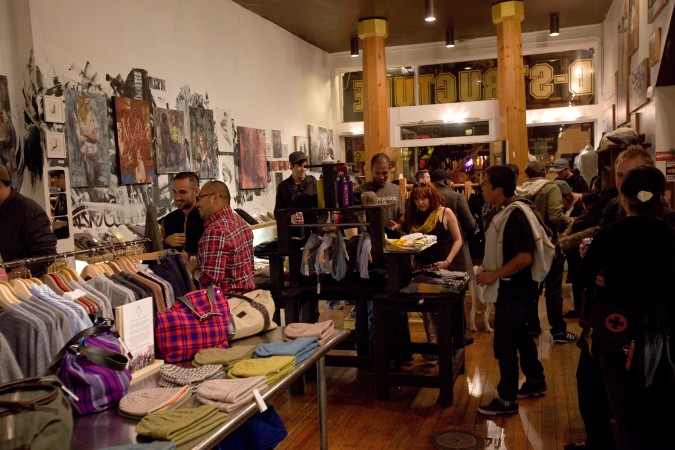
Art opening at D-Structure at 520 Haight Street, San Francisco, California, September 7, 2012. Photo by Kevin Warnock.
Devon Chulick, the new President of the Lower Haight Merchant Association, and the co-owner of D-Structure, introduced me to the artists — Megan Wolfe, Steve Javiel and Daniel Valadez.
The artists spent over 12 hours painting the wall that their artwork is displayed on, which you can see in the photographs above. Since this is original artwork, perhaps Chulick will find buyers for the drywall before this show is complete, to avoid having to paint over the large format piece. I loved the wall painting, as it tied the work of the three artists together, even though their styles are distinct.
I was in a rush to get to another art gallery opening, so I only spent about 45 minutes at the show. I didn’t get to interview the artists or really study the artwork, sadly, so I am sorry I can’t write a full blog post about this show. I like the art, particularly that by Javiel. I invite you to visit the websites of the artists, where you can see better quality photographs of their work. The color quality of the photographs I shot of their work is likely to be far off, as the lighting was not ideal for making accurate representations. The lighting was ideal for creating a warm and inviting atmosphere for an art opening.
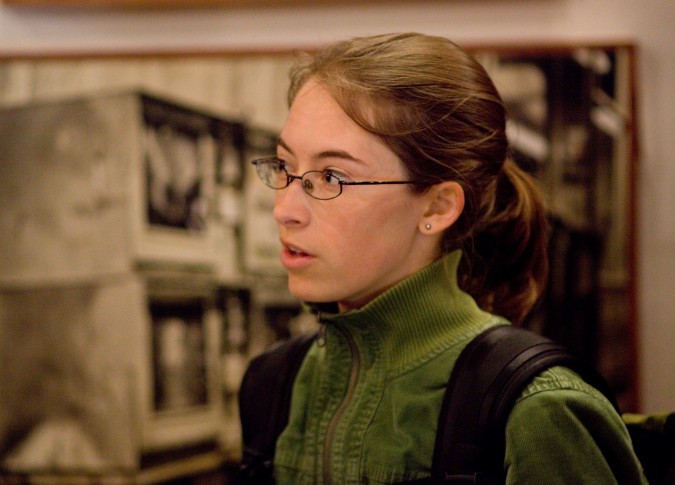
Megan Wolfe at her art opening at D-Structure, September 7, 2012 at 520 Haight Street, San Francisco, California USA

Steve Javiel at D-Structure gallery opening at 520 Haight Street, San Francisco, California USA. Photo by Kevin Warnock, September 7, 2012.
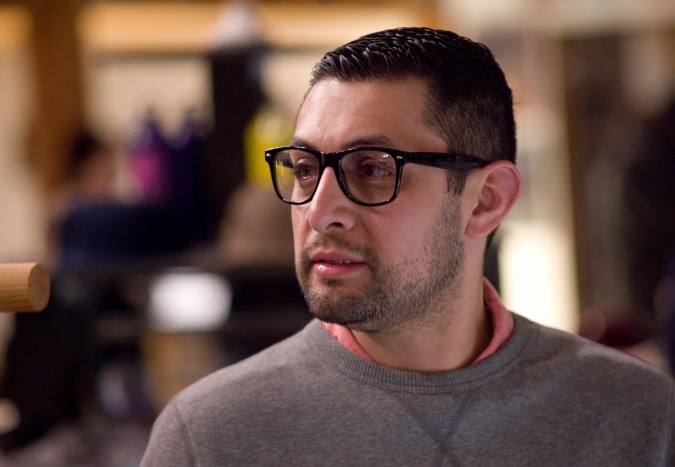
Daniel Valadez at D-Structure gallery opening at 520 Haight Street, San Francisco, California USA. Photo by Kevin Warnock, September 7, 2012.
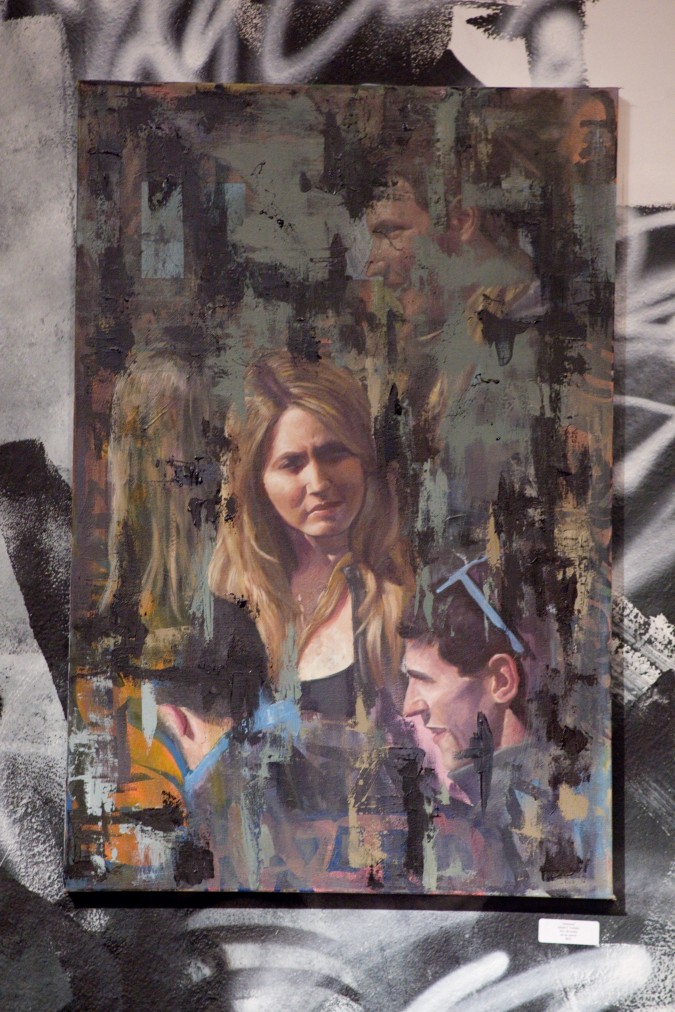
Artwork by Daniel Valadez at D-Structure gallery, September 7, 2012, 520 Haight Street, San Francisco, California USA
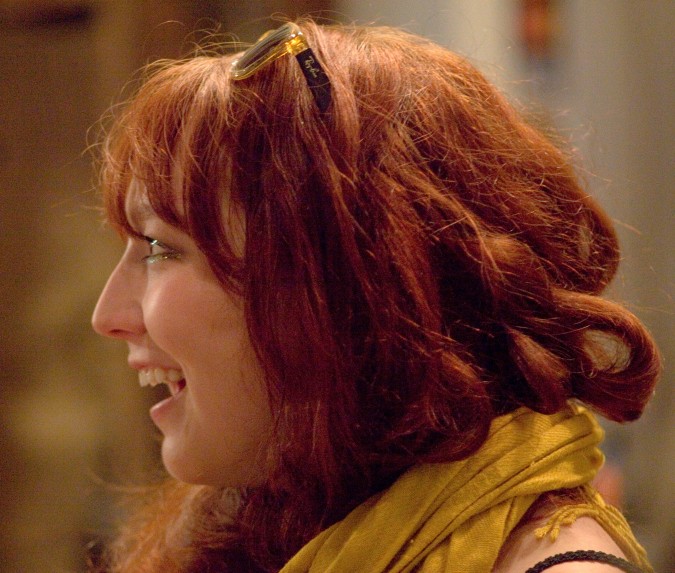
Jenya Rafi at D-Structure art opening at 520 Haight Street, San Francisco, California USA, September 7, 2012
To see these pictures at full resolution of 21 megapixels, please click on them twice in delayed succession. I used a Canon 5d Mark II camera and the following lenses: Canon 135mm soft-focus lens set to sharp, Canon 50mm macro lens, Canon 16-35mm L zoom lens.
Hana Alyssa Sidia gets the credit for my attending this art opening. I met Sidia at the Modify Watches event and she invited me to attend the art openings which she says D-Structure stages about once a month.
Click here to see all the posts I have published to this blog about D-Structure
Modify Watches trunk sale and party at D-Structure at 520 Haight Street, San Francisco
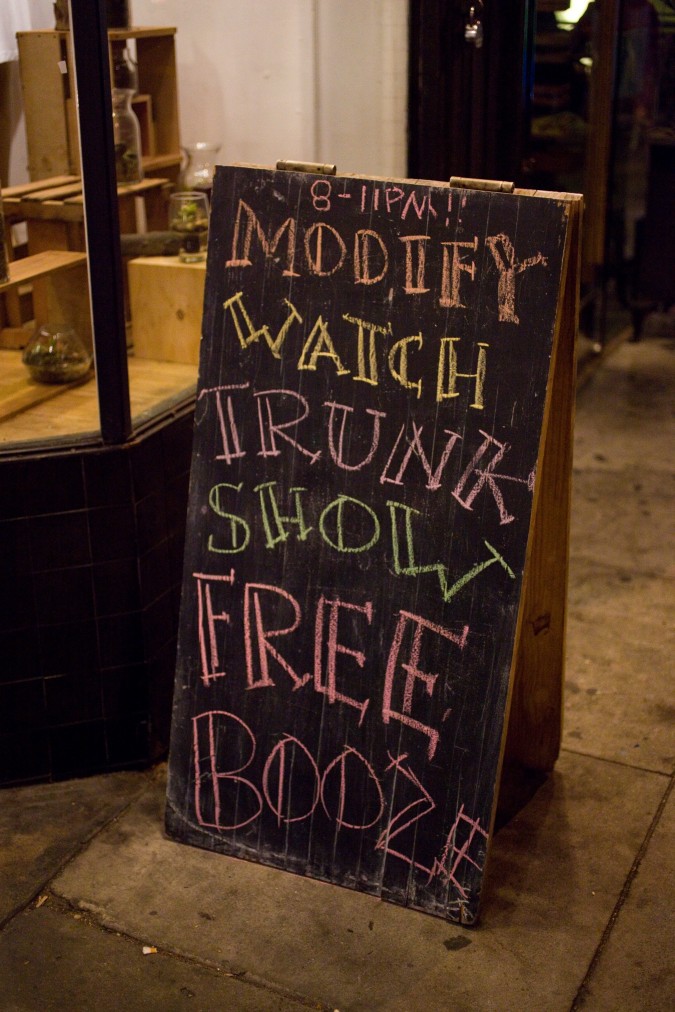
Modify Watches trunk show sign at D-Structure, 520 Haight Street, San Francisco, California, August 25, 2012
On Saturday, August 25, 2012, I attended a trunk sale at D-Structure, a clothing boutique and art gallery at 520 Haight Street in San Francisco, California USA.
Modify Industries, Inc. was the guest of honor at this trunk sale, showing their fashionable colorful Modify Watches brand wrist watches. The vibe at this trunk show was outstanding, due in part to the trendy location of D-Structure, between Mad Dog in the Fog at 530 Haight Street and Cafe International at 508 Haight Street, in the Lower Haight neighborhood.
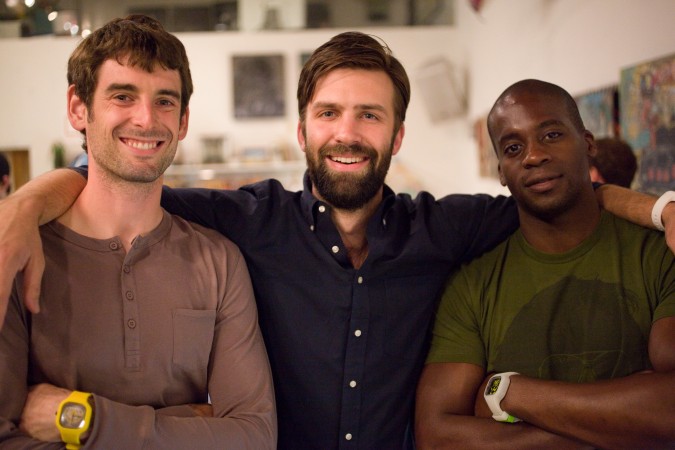
Aaron Schwartz, Devon Chulick and Ayo Oluwole at D-Structure, 520 Haight Street, San Francisco, California USA, August 25, 2012. Photo by Kevin Warnock.
I got to meet Devon Chulick, one of the co-owners of D-Structure.
Chulick told me that Aaron Schwartz came into his store to propose that D-Structure carry the Modify line.
Schwartz is the CEO of Modify Industries, and I didn’t know he made sales calls like this. Chulick told me he is totally bombarded with pitches from companies asking his store to carry their products, so Schwartz had to clear a high bar to get his product into D-Structure, which, from what I can tell, is well curated for its location and apparent target customers.
Schwartz, Chulick and Ayo Oluwole are pictured together above. Each is wearing a Modify Watches watch.
Oluwole is the VP of Marketing for Modify Watches. He used to live in New York where he did marketing for true luxury brands like Salvator Ferragamo. At Modify, I see evidence of Oluwole’s past experience with luxury goods — even his business car looks luxurious, with one rounded corner and muted pastel colors.
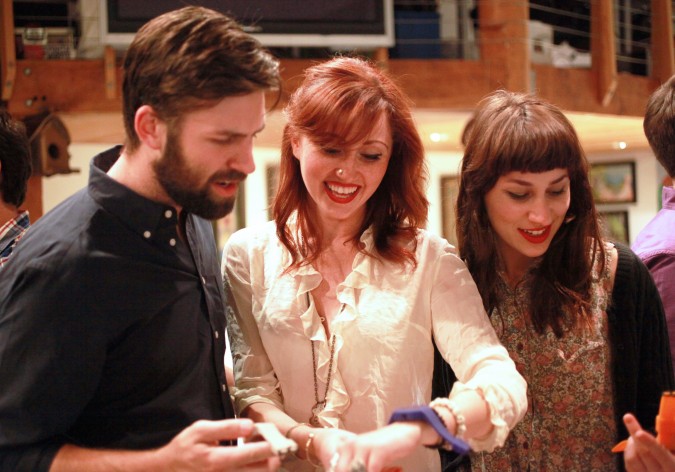
Devon Chulick, Hana Alyssa Sidia and Mary Frances Knapp at D-Structure, a clothing boutique at 520 Haight Street, San Francisco, California, August 25, 2012. Photo by Kevin Warnock.
Schwartz is a great salesman, once selling thousands of watches to a Silicon Valley company that’s known world wide after he was randomly seated on an airplane flight next to a buyer from that company.
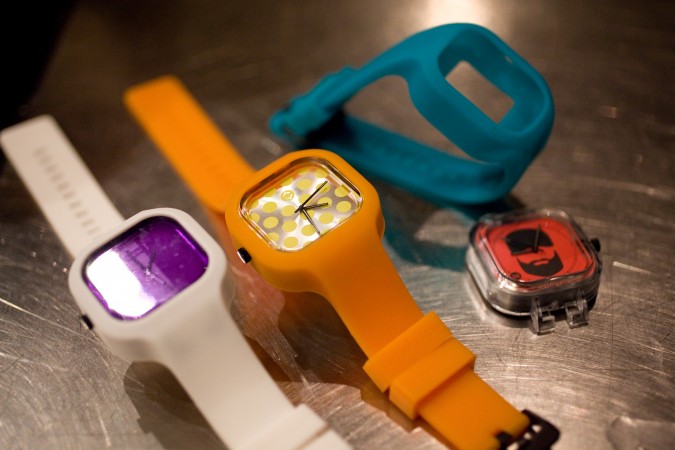
Modify Watches brand wrist watches by Modify Industries, Inc., August 25, 2012, D-Structure, 520 Haight Street, San Francisco, California USA. Photo by Kevin Warnock.
The watches are named Modify Watches because they are so easy to modify, without tools. The strap is made of soft and pliable silicone rubber, so one may take out the hard plastic time piece just by pushing it out of the strap. In the photograph above, you can see two complete watches on the left, and an empty watch band on the right, with the time piece sitting next to it. The time pieces and straps come in small and large — for women and men. The straps come in dozens of colors and the time piece inserts come in dozens of designs. Companies can order custom faces for the time pieces, in quantities as small as 200, the last time I heard. The swap-ability of the straps and time pieces gives buyers more fashion looks for less money. Modify Watches are simply fun, so I can see people buying them even if they carry a mobile phone, which, after all, is close to carrying an atomic clock in your pocket, because cell phones would not function if not for the extreme precision of the clocks the carriers use to make cell phone networks operate.
I’ve written about Modify Watches brand watches before, so I’ll tell you a bit about D-Structure. The store is beautiful — hip, quirky, warm and energetic. There was a quality DJ on hand for the event, and the sound system had quite good fidelity, and was loud enough to make you feel like music is a key element of the marketing strategy for the venue. It wasn’t loud like a nightclub, but it wasn’t soft either. It made the event feel like a real event, not a sales pitch.
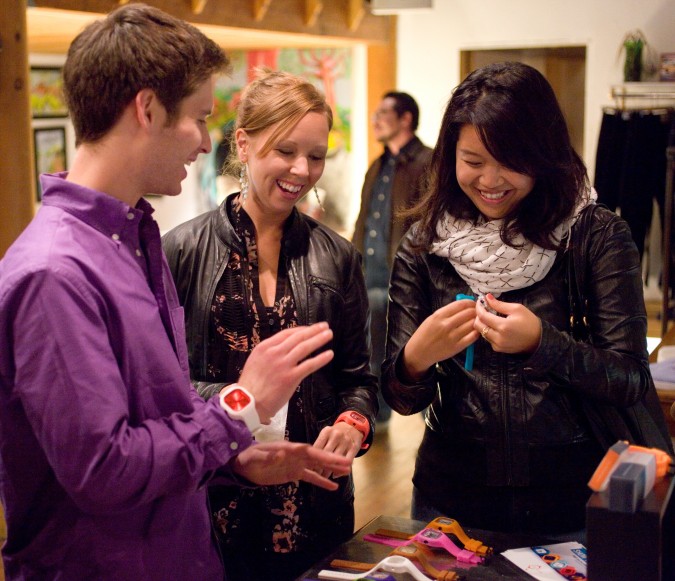
Devin Hexner and three fans of Modify Watches at D-Structure clothing boutique, 520 Haight Street, San Francisco, California USA, August, 25, 2012
Devin Hexner, an intern at Modify Watches, kept busy, and seemed to be doing a good job. I overheard him talking to some fans who work at a big national retailer, and Hexner sure looked like he was making a good impression, from all the smiles and laughter I saw.

Julia Garcia, left, and Shane Rand, right, at Modify Watches trunk sale at D-Structure at 520 Haight Street, San Francisco, California USA, August 25, 2012. Photo by Kevin Warnock.
I met a lot of people at the event. I spoke for a bit with Julia Garcia and her friend Shane Rand, pictured above. Garcia introduced herself to me because I had on my crushed red velvet sports jacket I got at a pop up sale for 90% off its original eye popping four figure price. I almost didn’t buy that jacket because I worried it would make me look like a young Hugh Hefner. I am thankful I bought it, since I have never owned an article of clothing that has garnered more compliments.
I would love to conduct one of my photoshoots of models in this store, with the model or models wearing some of the outfits the store has for sale. The location is very photogenic, as you can see in the photographs that I took that illustrate this post. Garcia and Rand are photogenic, so perhaps I can photograph them in the store, if they find this post and are interested.
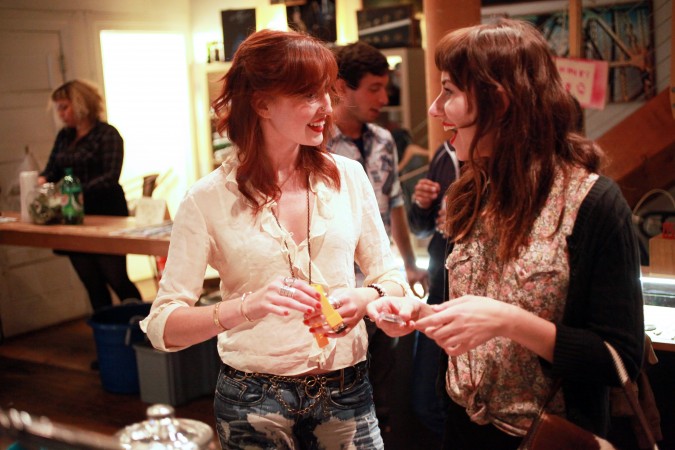
Hana Alyssa Sidia and Mary Frances Knapp at D-Structure August 25, 2012, 520 Haight Street, San Francisco, California USA. Sidia and Knapp are trying on time pieces by Modify Watches.
Hana Alyssa Sidia and Mary Frances Knapp, the only two models I introduced myself to at the event, are photogenic, and I would enjoy having a chance to photograph them properly, with my lights and reflectors.
This trunk show was at night and I used only the ambient light available. This means I had to choose an ISO setting of 4,000, so these pictures are more grainy than usual. I upload my photographs at full camera resolution of 21 megapixels. To see the full size versions, click on the pictures twice in delayed succession.
The artwork is interesting — not something I would buy for my home, but it was engaging and fun. Totally appropriate and it improved the aesthetic of the shop. I especially liked the ‘antiques’ on display as decoration, including several manual typewriters from 50 or 75 years ago, and several cameras from the same time period.
Yellow 108 brand hats looked great. I need to get into wearing hats.

Old camera for decoration at D-Structure, 520 Haight Street, San Francisco, California, USA, August 25, 2012
Look, a Schneider-Kreuznach lens on a camera that didn’t display its own brand where I could see it. I love old cameras.

Clothes on rack at D-Structure clothing boutique, 520 Haight Street, San Francisco, California, August 25, 2012
Modify Watches are water resistant, a point hammered home by the three watches on display in a bowl of water, above.
Modify Industries is on a roll. I enjoy attending their events. Schwartz has allowed me to borrow some of his company’s products, which I have some of the models I work with wear on camera. I will return all these watches, and I did not write this or any post about Modify in exchange for this loan. Schwartz is my friend, and I like writing about companies where I know the founder or founders. I make this disclosure because it may be legally required.
Modify Watches retail launch party at Hangr 16 boutique in San Francisco, California USA, August 9, 2012
On Thursday, August 9, 2012 I attended the retail launch party for Modify Industries, Inc.
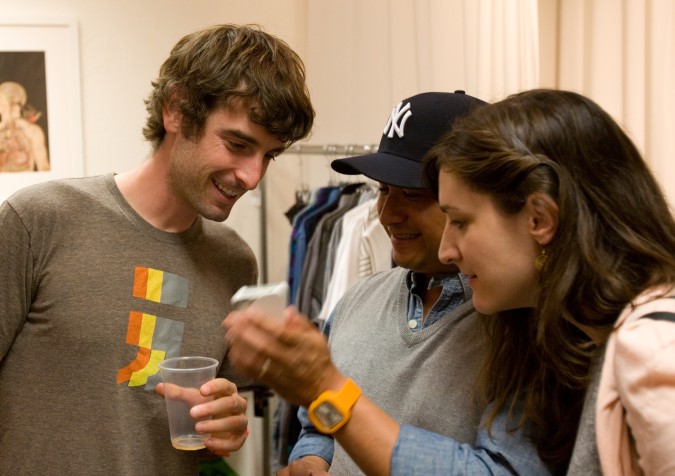
Aaron Schwartz, left, CEO of Modify Watches, checks out an Apple iPhone app August 9, 2012 at Hanger 16 at 3128 16th Street, San Francisco, California USA
Modify Industries is the company behind the colorful and fashionable silicone rubber Modify Watches brand watches that feature time pieces that without tools may be interchanged between bands. You can see people wearing Modify Watches in the top three photographs that illustrate this post. The watches come in two sizes. There are dozens of time pieces and dozens of straps (bands) to select from.
Modify Watches was a finalist competitor in the 2012 Berkeley Startup Competition at the University of California. That competition is very competitive, and it’s very difficult to become a finalist, as there are only eight per year, while most years more than 100 teams apply to compete.
I am friends with Modify CEO Aaron Schwartz.
Click here to see all my blog posts, past and future, that I have written about Modify Watches.
Modify has focused its attention on eCommerce sales and enterprise sales. It has achieved impressive success in both areas, selling to big companies including Google.
Now Modify is moving into retail by selling to boutique retailers.
One such boutique is Hangr 16 at 3128 16th Street in San Francisco, California USA, near Valencia Street. Hangr 16 carries the Modify line of products. The store’s energetic and charismatic buyer, Liddy Parlato, decided to sell Modify’s eye catching line after she opened an email targeted to her store from the company. Parlato told me she gets 30 pitches a day by email. Parlato’s store is spare and elegant, with a well curated selection. It’s not jammed with hundreds of product lines like many boutiques. Thus, Parlato’s decision to carry Modify’s products is a win for Schwartz and his team. Parlato is one of four owners of Hanger 16. She comes from a background in advertising, not retail.
While researching this blog post, I learned that Hangr 16 was voted the Best Clothing Store for Men by readers of the San Francisco Bay Guardian weekly newspaper. That makes the store’s decision to sell Modify Watches all the more special.
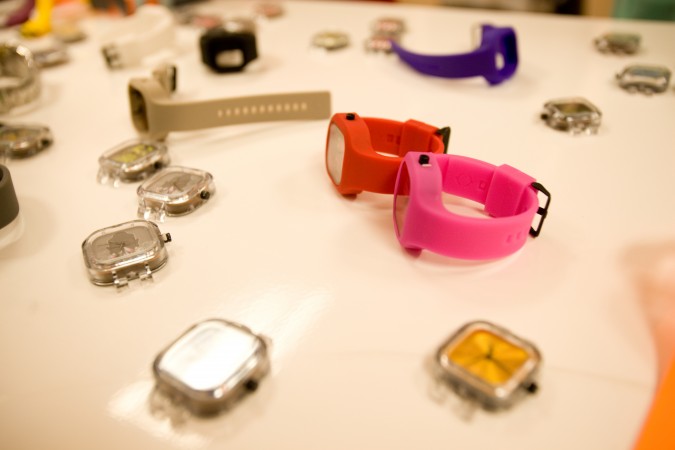
Modify Watches still life at Hanger 16 retail launch event August 9, 2012 at 3128 16th Street San Francisco, California USA
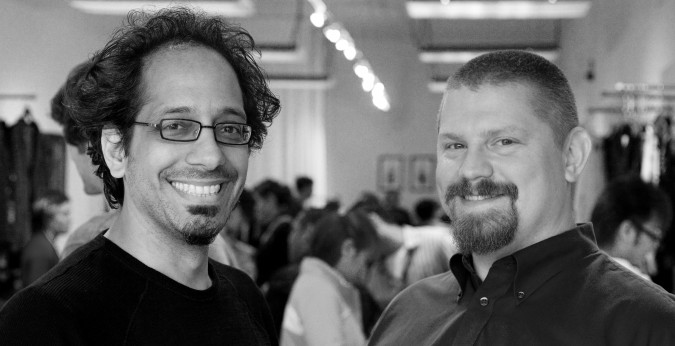
Abie Hadjitarkhani and Nathan Dintenfass, founders of Hotel Delta, at Modify Watches retail launch party, San Francisco, California USA, August 9, 2012
Abie Hadjitarkhani and Nathan Dintenfass attended the launch party. I know Dintenfass from the Haas School of Business at the University of California Berkeley. I met him while he was getting his Masters of Business Administration degree. I participate in many events at Haas to help the students and by extension The Lester Center for Entrepreneurship and Innovation.
Dintenfass and Hadjitarkhani run Hotel Delta, a boutique consultancy that helps entrepreneurs create great products.
Hotel Delta produces the Products are Hard conference.
Nathan Dintenfass is one of the smartest entrepreneurs I know. I have spent hours listening to him advise startups, and his wisdom is evident and deep.
Congratulations to Schwartz and his impressive team at Modify Industries. I predict great things to come.
I took the pictures that accompany this post. I uploaded them at full camera resolution of 21 megapixels. Click on them in delayed succession to see the full size versions, which are larger than your screen.
Legal disclosure — Schwartz let me borrow six of his company’s watches so that I may photograph them being worn by the female models I photograph. I pursue photography as a hobby, and do not charge for my work, so perhaps this disclosure is not legally required. To cover my bases, I am disclosing this loan. I proposed this arrangement, not Schwartz. I would have written this post even if Schwartz did not let me borrow any watches. I will return the watches to Schwartz once I photograph them with some additional models.
2012 Berkeley Startup Competition Finals at University of California Berkeley
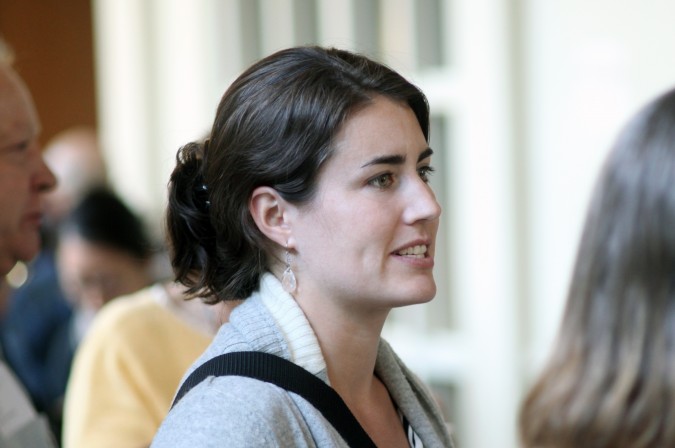
Kate Garrett, co-founder of Calcula Technologies, Grand Prize winner of the 2012 Berkeley Startup Competition, April 26, 2012
On Thursday, April 26, 2012, I attended the Berkeley Startup Competition Final Awards Ceremony at the Anderson Auditorium on the campus of The Haas School of Business at the University of California at Berkeley. Here is the PDF format file of the 2012 Berkeley Startup Competition Final Awards Ceremony program booklet that was handed out at the final awards ceremony.
There are many people mentioned in the booklet, like the Co-Chairs for the 2012 competition, Nick Nascioli, Adam Sterling and Tom VanLangen, as well as Lester Center Executive Director Andre Marquis and Haas School of Business Dean Richard Lyons.

Grand Prize winner Calcula Technologies at the Berkeley Startup Competition, April 26, 2012. Left to right: Nick Mascioli (co-chair of the Competition), Adam Sterling (co-chair of the Competition), Kate Garrett, Dan Azagury, David Gal, Buzz Bonneau, Tom VanLangen (co-chair of the Competition)
I most recently wrote about the announcement of the finalists for this competition, which happened two days earlier, on April 24, 2012.
Calcula Technologies won the Grand Prize and the Life Sciences Track for their clever system that vacuums kidney stones out of a patient’s urethra in just ten seconds. According to the team’s presentation, doctors today let stones pass from the body naturally and often quite painfully unless they are larger than 10mm in diameter. Patients today are often in such agony that they visit the emergency room, which racks up hundreds of millions of dollars in charges per year. For the sub 10mm stones, doctors just write prescriptions for narcotic pain killers and send the patients home with the stones still on their excruciating slow path out.
In the future, when and if Calcula gets their system approved by regulators, patients could have a catheter inserted into their urethra and the stone could be sucked out in seconds, presumably at great relief to the patient. This work could be done at the office of a urologist, without surgery, and the Calcula team said there is already a prized and lucrative reimbursement code in existence in the insurance industry, so if they build this system, they will be able to get paid and make a profit. I can understand why Calcula Technologies won the grand prize. Kidney stones are no fun, I’ve heard, and this system seems very appealing. The team showed a video of a fake kidney stone being sucked out of a pig’s urethra in just 10 seconds. It was very impressive and very memorable.
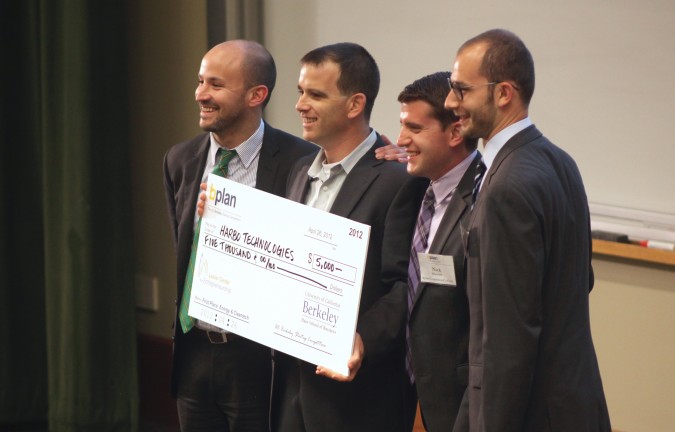
First Place Energy and Cleantech winner Harbo Technologies at the Berkeley Startup Competition, April 26, 2012
Kloudless, Inc. won first place in the Information Technologies and Web Track. I am going to be interviewing Kloudless, so I’ll save my remarks for another blog post.
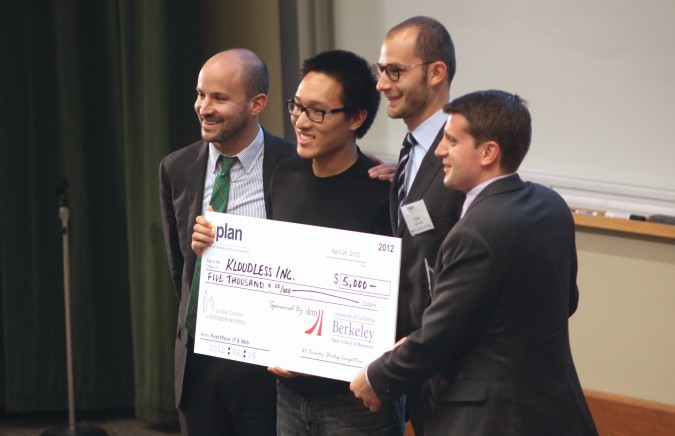
First place IT and Web Track winner Kloudless, Inc. at the Berkeley Startup Competition, April 26, 2012
Like Calcula, Back to the Roots (2935 Adeline Street, Oakland California 94608 USA) won two awards. First, they won the Products and Services Track, and then, thanks to real time votes from the audience and viewers of a live stream on the Internet, they won the Peoples’ Choice Award.
I have written about Back to the Roots twice before.
I have one of their products at my house right now. It works.
Back to the Roots collects used coffee grounds from coffee houses like Peet’s Coffee and mixes it with a ‘secret sauce.’ The combination is boxed up and sold at over 1,000 stores in the United States, including at Home Depot and Whole Foods Market. A consumer buys the cardboard box and partly opens it, exposing the insides. The consumer then mists the contents of the box with water using an included spray bottle. After ten days of twice daily misting, the consumer harvests a bountiful crop of oyster mushrooms that have grown directly out of the side of the box. Once one side has been used up, the consumer opens the other side to repeat the growing cycle for a second harvest.
That story has been told thousands of times, including on the CBS Evening News, an influential national newscast in the United States.
During their public presentation, the Back to the Roots team disclosed future plans that I find fascinating. Since this event was public and was streamed live to the Internet, I feel that it’s OK to write about what I learned, as there were no statements that anything said was to be considered secret.
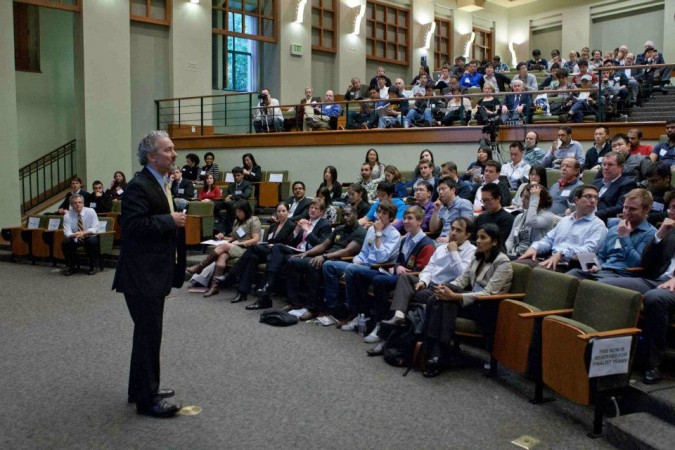
Haas School of Business Dean Richard Lyons speaks at the Berkeley Startup Competition Finals, April 26, 2012. Photograph by Bruce Cook.
The box contents will soon include vegetable plant seeds, and the rest of the box and liner will be biodegradable. Currently, the box is lined with what looks like conventional plastic. My box is from November, 2011, so things today may be different. In the future, or perhaps even already, the box will be lined with either nothing or something else that’s biodegradable. Perhaps what looks like conventional plastic to me is really biodegradable plastic, like some plastic trash bags are made of.

Venture capitalist Michael Berolzheimer, of Bee Partners, attends the Berkeley Startup Competition, April 26, 2012. Berolzheimer also leads the Haas Founders group that I am a member of.
Why do this?
Once the box is biodegradable and contains vegetable seeds, that means that after the two mushroom harvests the box can be planted in dirt for ’round three’ of production — vegetables. The mushrooms came from the waste stream from coffee houses. The round three vegetable garden will come from the waste stream of the mushroom garden.
This is beautiful.
What’s coming down the road from Back to the Roots?
I am overjoyed to report the answer may be affordable aquaponics kits.

Kevin Esse at networking hour prior to attending Berkeley Startup Competition Finals, April 26, 2012
I have written before about my love for aquaponics.
Aquaponics is food production gardening enhanced by growing edible fish in symbiosis with vegetable plants. Both parts of the system are made more productive by the presence of the other half. Fish poop gets converted by bacteria into rich fertilizer. The fish grow faster because the plants keep the fish tank cleaner. It’s a great growing system that I feel should take over the world on such a scale that every person has their own system at home.
I am too busy in life to advance this dream, but the team at Back to the Roots has time and energy and market traction, so I think they would be ideal to push aquaponics to a large audience. I am so excited about this that I have already offered to tell the company everything I know about aquaponics free of charge to encourage them to get this to market.
I suspect they plan to start with small, under USD $100 demonstration kits. This in my mind is the way to start.
I bought my startup supplies for my aquaponics system from The Aquaponics Source. This online retailer sells complete systems, but the price is too high for people to buy casually, at over USD $1,000. I believe a profitable sub $100 kit could be sold, as what’s required is similar to what’s inside a Mr. Coffee brand coffee maker — two water containers, a pump, a heater and some electronics to coordinate the steps. I can get a nice computerized Mr. Coffee coffee maker for about USD $25 from Amazon, so even in the smaller quantities a demonstration aquaponics system would sell in initially, I think it can be done.
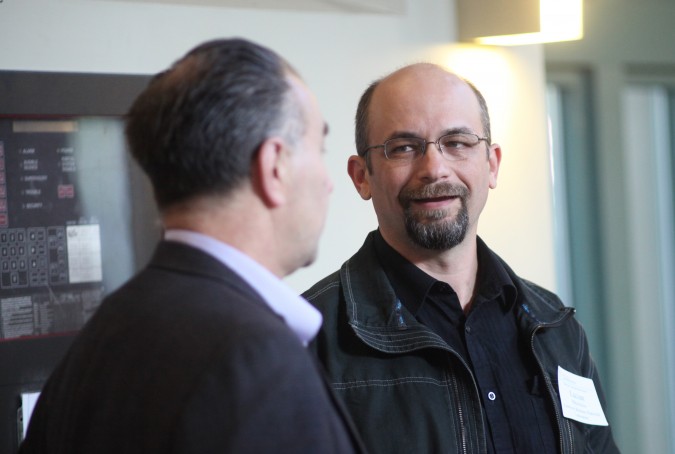
Lucian Mihailescu of Lawrence Berkeley National Laboratory attends the Berkeley Startup Competition, April 26, 2012
I love advising startup companies, and I would particularly like to advise about aquaponics, even though I know relatively little about the subject, since I’ve only built one demonstration system so far. My system was a modest success for I grew the largest and sweetest tomatoes I have ever eaten.
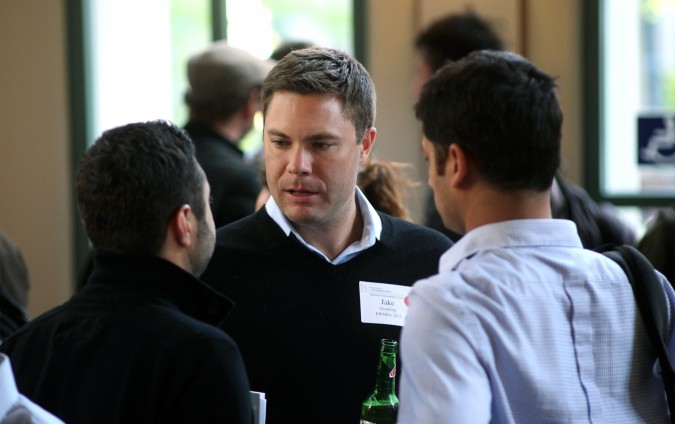
Jake Gentling at the networking hour prior to attending the Berkeley Startup Competition Finals, April 26, 2012
HARBO Technologies won First Place in the Energy and Cleantech track. I introduced myself to co-founder Boaz Ur and mentor John Matthesen after the conclusion of the event. The company is working on something I find impressive and interesting. I have made arrangements to interview the team, so I will hold my remarks until after that interview.
My friends at Modify Industries took home a USD $1,000 prize for coming in second place in the Products and Services Track. This outcome was inevitable, and I predicted it accurately the moment I saw Modify was competing with Back to the Roots. Back to the Roots simply has had much more commercial success so far. While Modify has sold between 10,000 and 100,000 watches to such companies as Google and Hewlett Packard, they haven’t yet cracked the retail store market, and they haven’t been on the evening television news. It’s rare for a company to be so far along like Back to the Roots, but still be eligible to compete in the Berkeley Startup Competition. In all other years where there was a Products and Services Track, Modify probably would have won that track. I pay attention to these things because I was a judge for this competition for the eight years through 2011. This year I mentored the team University Gateway, which did not make it to the finals since Modify and Back to the Roots filled up the Products and Services Track.
Modify gave an impressive and bold presentation, where they outlined a dream for their enterprise far bigger than time pieces. They probably adjusted their pitch to compete with Back to the Roots. But they forgot to show their product in action amid all the grand dream spinning. How so? They forgot to personally show the audience how to change a watch element from one silicone strap to another. This is worth showing at every pitch for it’s compelling and like nothing I’ve seen in the watch business. No tools, no training — 10 seconds and you have an all new look.
Finally, I want to give some space to my friend and fellow photographer Bruce Cook. I’ve known Cook since nearly the inception of The Lester Center for Entrepreneurship & Innovation. He’s a fixture at all sizable Lester Center events. He has his own photography business, Bruce Cook Photography, and is not a University of California employee. I can’t recall there ever being a different photographer for a Lester Center event. The picture above is of Cook standing under the video light in Anderson Auditorium. The picture below is of Cook taking a picture during the networking hour in the Bank of America Forum, the large gathering area just outside of the Anderson Auditorium. Cook took the picture above of Dean Lyons speaking to the audience. Thank you Bruce!
If The Lester Center is reading this, may I suggest that you contact Cook and work out a deal where his vast library of photographs of Lester Center events over the last twenty years can find a permanent home on the Lester Center website and in the University library system. Cook has photographed some of the most important figures of our time, and the tremendous majority, over 99%, of his photographs have not been published. I think these photographs should also be published on Facebook so that it’s easy to crowd source the identification of the people in the pictures, via the Facebook tagging system. Once the faces are tagged, then the captions on the Lester Center website can be updated to reflect the identities of those pictured.
Why do this?
The Lester Center and its events are documenting history. It’s that simple. Bruce Cook has a treasure trove of historic pictures that few have ever seen.
As an added bonus, publishing and captioning Cook’s 100,000+ pictures will boost traffic to The Lester Center’s website, as people search on Google and similar sites for the many luminaries Cook has photographed. The search engine optimization benefits to posting these pictures will probably overshadow every other single project you could undertake.
This is my idea alone.
Cook did not plant this, suggest this or hint at this.
I’ve been thinking about this for years now, and here seems like a fine place to promote the idea.
I believe I have shared this suggestion with Jerry Engel when he was Executive Director of The Lester Center, but that was only in passing at a hectic Berkeley Entrepreneurs Forum, not a written proposal such as this one.
Please consider this official advice, and let me know when I can blog about the happy news. Thank you.
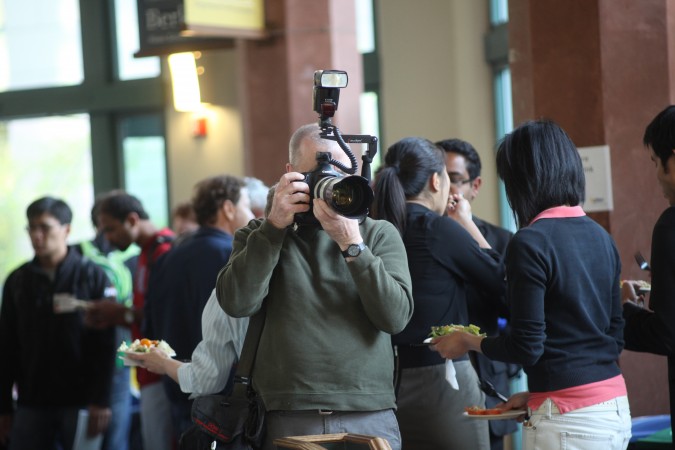
Bruce Cook, the photographer for The Lester Center events, covers the Berkeley Startup Competition, April 26, 2012
I introduced myself to all the finalist teams except AdrenaRX. I believe the members from that team departed before I had a chance to find them.
I offered each of the eight finalist teams except for Modify and Back to the Roots the opportunity to be interviewed by me for a future blog entry. Two of the teams have contacted me to schedule an interview. Four teams have not yet contacted me.
I know the Modify and Back to the Roots founders, so I did not offer to interview them. This was not meant as a snub — I simply forgot to offer in my excitement of congratulating them. Both teams are doing so well they don’t need my blog coverage, but if they would like more in depth stories, I am happy to meet with them. Just send me a message. I am on Facebook and easy to reach. I have turned on the ‘subscribe’ feature, so everyone reading this is invited to subscribe to me on Facebook. You may also sign up with your email address to receive updates to this blog, in the upper right corner of this page.
All the pictures I presented above except for the one by Bruce Cook are also on my Facebook page in this album. If you know these people, particularly the people in the shots with the giant checks, please tag them on Facebook so I can update the captions here with the names. All my pictures on Facebook are public, so if you tag someone there, I consider those names to be public, and on that basis I will update the captions here.
The sponsors for the 2012 Berkeley Startup Competition include:
Gold level:
Claremont Creek Ventures
DCM
UM
Silver level:
Javelin Venture Partners
Lowenstein Sandler
Mintz Levin
Mohr Davidow
Morgan Stanley
Morgenthaler Ventures
Morrison & Foerster LLP
Wilson Sonsini Goodrich & Rosati PC
Individual level:
There were possibly other individual sponsors. No individual level sponsors were listed in official materials this year, a departure from past years.
The Executive Committee for the 2012 Berkeley Startup Competition:
Co-Chairs
Nick Mascioli
Adam Sterling
Tom VanLangen
Judging & Sponsorship
Robbie Allan
Jane Buescher
Vivien Leong
Larry Pier
Marketing & Events
Stephanie Knoch
Krishna Shah
Mentorship & Events
Amara Aigbedion
Hrishikesh Desai
Program Manager
Kirsten Berzon
Berkeley Startup Competition finalists, including Back to the Roots and Modify, are announced
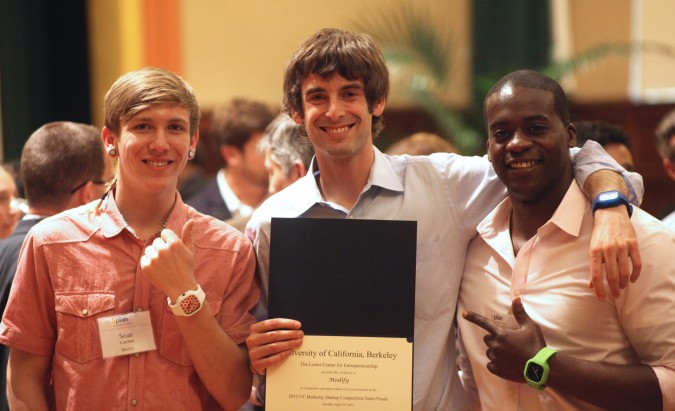 HARBO Technologies
HARBO TechnologiesSean Linehan, Aaron Schwartz and Ayo Oluwole of Modify, April 24, 2012. Modify is a finalist in the 2012 Berkeley Startup Competition.
Last night, on April 24, 2012, I attended a reception at the University of California Berkeley Clark Kerr Campus. The reception was held to announce the finalists for the 2012 Berkeley Startup Competition. This event used to be called the Berkeley Business Plan Competition. I competed in the finals of this competition in its inaugural year, and have sponsored the competition every year since, including in 2012.
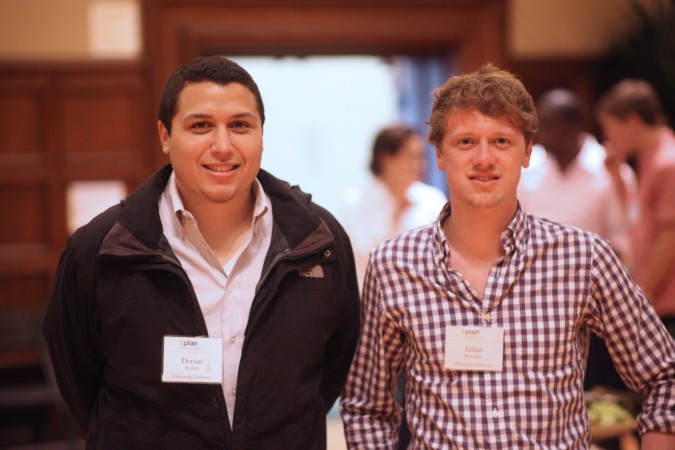
Dorian Walder and Julian Riediger of University Gateway, April 24, 2012. Kevin Warnock mentored this team this year.
This year I was a mentor to semi-finalist team University Gateway, lead by Dorian Walden. I got to know Walden over four meetings, some of them stretching to 3 hours around my dining room table. Sadly, University Gateway did not progress to the finals, but it was easy for Walden to understand why.
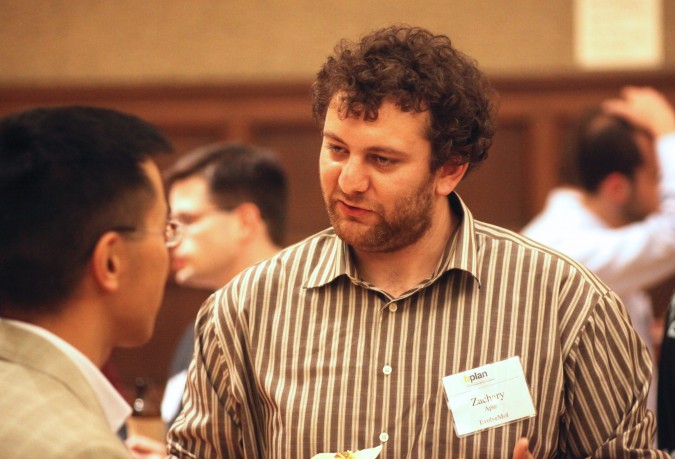
Zachary Apte of EvolveMol, April 24, 2012. Apte is at the Berkeley Startup Competition finalists announcement reception.
Two teams I know personally were in the same judging category as University Gateway — Products and Services. University Gateway is an Internet company, but the track for Internet companies apparently was filled up already. This meant University Gateway was competing with companies that make and sell physical goods.
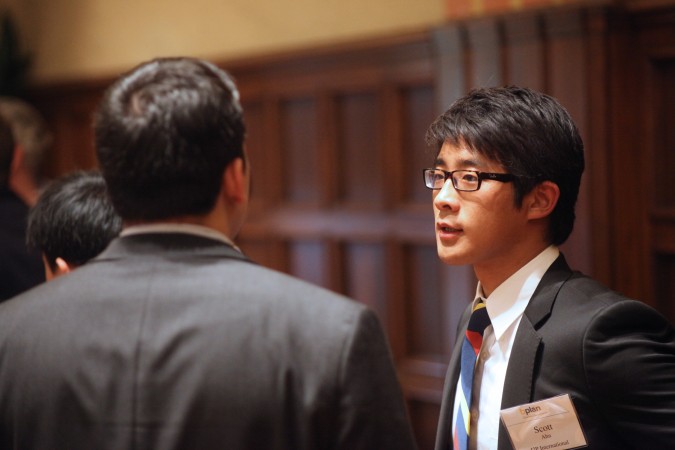
Scott Ahn of J2P International, April 24 2012. Ahn is at the Berkeley Startup Competition finalists announcement reception.
The teams I know that competed in the Products and Services track both were advanced to the finals. I was 99.9% confident that this would be the result, even though I knew nothing about the other competing teams. I was so confident because the teams I know are so strong, and I have been a judge for this competition for the past 8 years or so. I know from experience that teams this strong always make it to the finals.
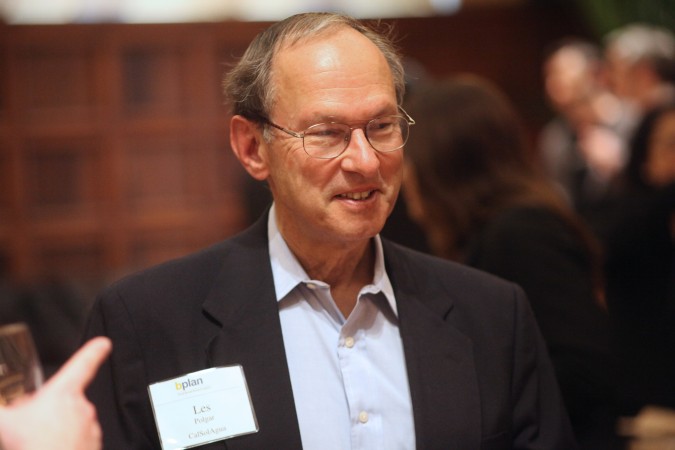
Les Polgar of CalSolAgua, April 24, 2012. Polgar is at the Berkeley Startup Competition finalists announcement reception.
I also know that teams this strong are very rare, so it was unlikely that the Products and Services track had any other teams so strong. I have never gone home from judging thinking that a third team from my judging track should have gone on to the finals.
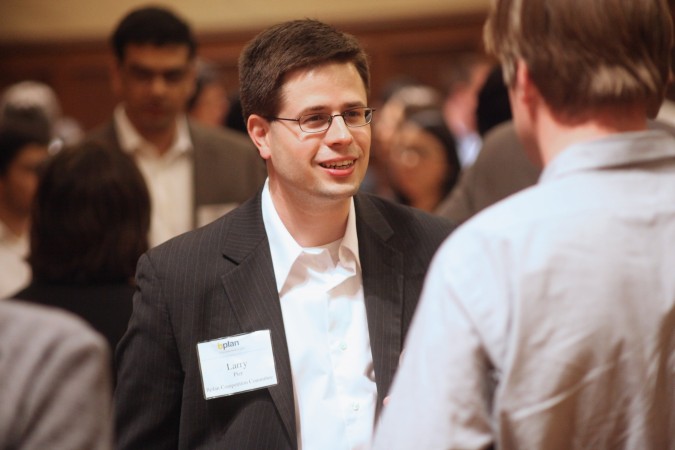
Larry Pier of Berkeley Startup Competition, April 24 2012. Pier is at the Berkeley Startup Competition finalists announcement reception.
University Gateway has a good idea, and I hope that Dorian Walder and Julian Riediger make their venture a success. The company is still in stealth mode, so I won’t tell you what they do yet.
The Products and Services teams that advanced to the finals are Modify and Back to the Roots. Both are unusual companies for this Berkeley competition.
Modify makes wrist watches that you can change easily to suit your tastes. The straps are made from silicone, similar to what silicone bake ware is made from. One can pop the time piece out of the strap/case in just a second, with no tools or special skills required. The straps are available in bright colors, and I describe them as chunky chic. The team from Modify are each wearing a Modfiy watch in the photograph I took at the top of this post. I am friends with Modify founder Aaron Schwartz. We see each other most months at the Haas Founders group I wrote about March 11, 2012.
Schwartz is a likeable and modest guy — only when researching this blog post did I discover he’s been profiled in a blog published by The New York Times newspaper. The New York Times is worth tens of millions of dollars less than photo sharing smart phone application Instagram, but I’d much prefer to be written about in a blog by The New York Times than in a blog by Instagram.
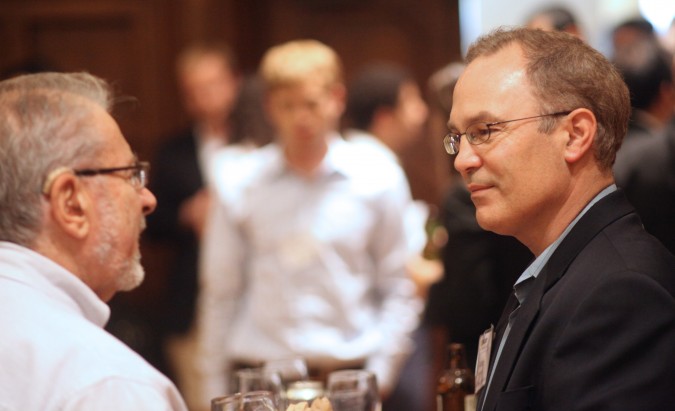
John Steuart of Claremont Creek Ventures, April 24, 2012. Steuart is a judge for the Berkeley Startup Competition.
Back to the Roots makes and sells affordable oyster mushroom growing kits. I’ve written about Back to the Roots when I saw their CEO Nikhil Arora speak on a panel at a Food Startups Meetup run by my friend Matthew Wise, the co-founder of both Founderly and Tableslice. Back to the Roots has 20 full time employees, or so I was told when I interviewed a staff member at their booth at the San Francisco Flower and Garden Show on March 24, 2012.
Back to the Roots has received lots of press coverage, including two minutes and forty seconds on the national CBS Evening News in the United States on March 15, 2012. The newscast says that Back to the Roots sells its products in over 1,000 stores and has 28 employees. Impressive.
Both Modify and Back to the Roots have businesses that are well along. Modify has sold _____ of thousands of watches to companies as well known as _____ and _____. [I’m waiting to hear from Schwartz to fill in the blanks in the last sentence. I know the values, but I want to verify the numbers and names I know are meant to be public information.] Back to the Roots sells its kits at Whole Foods Market and Home Depot. While Modfiy and Back to the Roots are still startups, they are making big strides and are companies to watch.
The reception was well attended and busy. I got to talk with my fellow judges from past years of this competition. I captured video. I took hundreds of pictures. I didn’t eat until the event was technically over. What I didn’t get to do, sadly, was interview the finalist teams that I didn’t know. If they are reading this and would like to be the subject of a future blog post, I invite them to contact me. I’ll meet you for coffee and you can give me your pitch and I’ll write about your venture.
Here is a list of the 2012 finalists for the Berkeley Startup Competition. The descriptive text that follows was provided by the teams themselves.
- Kloudless, Inc.
Kloudless is a free service that helps you manage all the things you put in the cloud. We enable users to search for, access, and manage their information that is spread across the Internet. We’re starting with email attachments, the black hole of cloud services, and will expand to other cloud services in the near future. Our solution addresses an increasingly large problem as more and more information moves into the cloud.
- Traverie
Traverie is an explorer focused startup that leverages the emotional, personal and inherently social aspects of travel discovery to make the process visual, fun and trustworthy. We bring structure to the current ad hoc and offline model of discovering and selecting destinations. We blend user-generated content, professional content and advertising to deliver a compelling user experience. Our founding team comprises a designer, engineer and product manager from MIT, Harvard and Berkeley-Haas, respectively.
- AdrenaRx
AdrenaRx is a biopharmaceutical company focused on the prevention and treatment of heart failure due to toxicity from cancer chemotherapy. Each year, 1.6 million Americans are affected by cancer, and a third of these patients receive chemotherapy that can damage their heart. AdrenaRx has identified a new therapeutic target and a potent, selective drug that can protect the heart from damage by chemotherapy, and reduce a patient’s risk of developing heart failure after surviving cancer.
- Calcula Technologies
Calcula Technologies is developing a novel urological medical device for the removal of kidney stones outside of the operating room. Our patent pending technology will treat 4M patients/year in the US and EU. With clear FDA predicates and existing CPT reimbursement codes Calcula will be a major disruption in the field of Urology.
- Claro Energy
Claro Energy provides solar-powered water pumping solutions to meet irrigation needs of farmers in remote power-deficit agriculture areas in India where costly diesel generated power is the default choice. Claro Energy’s solar-powered pumps have near zero operating costs, are longer lasting and highly reliable when compared to dieselpowered pumps. In combination with sales, marketing and business development competencies, Claro Energy has also developed in-house integration and implementation expertise in remote rural regions of India.
- HARBO Technologies
During the first critical hours, oil-spills spread, split, and create escalating irreversible damage. HARBO develops the only emergency oil-spill containment solution for immediate response. HARBO’s Zero Time to Spill system is at standby position on-board oil-tankers/rigs and other ships and deploys a boom (floating barrier) within minutes to contain spills. HARBO’s advantage: Minimizing environmental damage, avoiding large containment/cleanup expenses, offering superb costefficiency and preventing a PR nightmare. “Containing oil-spills when they’re small, preventing big disasters.”
- Back to the Roots
Back to the Roots, started by two Haas Business School undergrads, promotes sustainability and zero-waste, while reconnecting people to food through its grow-at-home mushroom kit. Our gourmet mushroom kits are made with 100% recycled coffee grounds, and produce 2 pounds of fresh oyster mushrooms in just 10 days! People of all ages can actually grow and eat their own mushrooms all at home, a unique experience in today’s urban lifestyle.
- Modify
Modify is a brand built on freedom of expression. Customizable for individual style, Modify’s interchangeable watches offer dope design for anyday wear. Available in two different sizes and over 250 combinations, Modify is a brand made for anyone—anytime, anyplace. A proponent of exceptional personalized service, we engage organizations and fans to help create (and name!) watches. Modify Watches are available for corporate gifting and licensing.
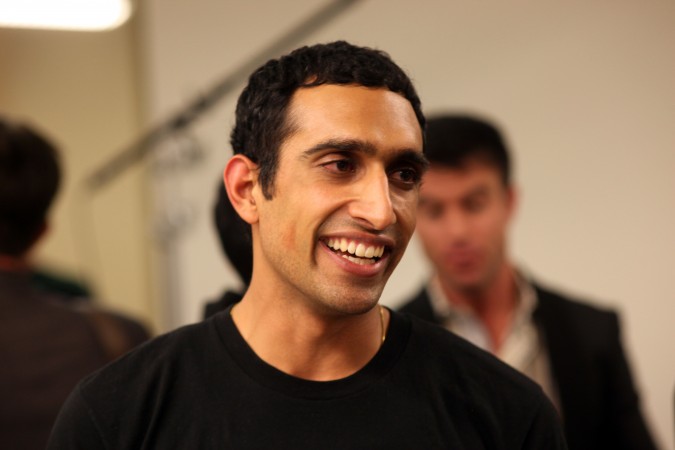
Nikhil Arora, the CEO of Back to the Roots. This was taken by Kevin Warnock on November 16, 2011, not at the Berkeley Startup Competition event.
Here’s the handheld video I captured of the finalist teams learning of their advancement and collecting their certificates documenting their achievements. Andre Marquis, the Executive Director of The Lester Center for Entrepreneurship & Innovation, delivers the opening remarks. John Steuart, Managing Director at Claremont Creek Ventures, comments on the judging process. Steuart’s firm is a financial sponsor of the competition, and Steuart is one of the judges.
—–
Anthony Franco of Better Cater, pictured above, contacted me and asked me to link to his startup’s website. Sorry for the delay in creating the link — I just saw your Facebook message from April 25th a few minutes ago. Kevin — May 3, 2012 @ 12:47am.
